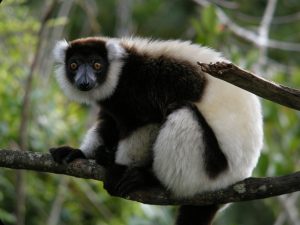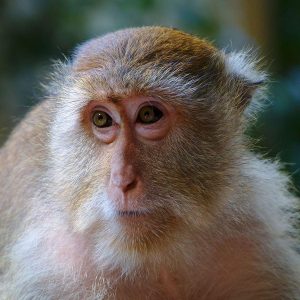5 Chapter 5: Primates
Amy Rector
By the end of this chapter, you should be able to:
- Discuss how primates are different from other mammals.
- Understand how studying non-human primates is important in anthropology.
- Identify different types of traits that we use to evaluate primate taxa.
- Describe the major primate taxa using their key characteristics.
- Understand your place in nature by learning your taxonomic classification.
What is a Primate?
Because humans are primates, we share a wide range of behavioral and morphological traits with the other species who also fall into this group. In a previous chapter, you learned about the nature of Linnaean classification, the system we use for organizing life-forms. Here, we focus on the organization and diversity within the Order Primates. The term Order Primates dates back to 1758 when, in his tenth edition of Systema Naturae, Carolus Linnaeus put humans, “simia” (monkeys and apes), “lemurs” (lemurs and colugos), and some bats into one of eight groups of mammals. Linnaeus was wrong in including colugos (now in Order Dermoptera) and bats (now in Order Chiroptera), but the grouping of humans with the then-known non-human primates was significant in that by doing so Linnaeus formally recognized the affinities between humans and these non-human taxa. In fact, acknowledgment of similarities between humans and non-humans dates back far earlier than Linnaeus, yet it was only more recently that we attained the genetic data to back up our intuition.
Primates are one of at least twenty Orders belonging to the Class Mammalia. All members of this class share certain characteristics, including, among other things, having fur or hair, producing milk from mammary glands, and being warm-blooded. There are three types of mammals: monotremes, marsupials, and placental mammals. Monotremes are the most primitive of the mammals, meaning they have retained more ancient traits than marsupials or placental mammals, and so, monotremes are characterized by some unusual traits. Monotremes, which include echidnas and duck-billed platypuses, lay eggs rather than give birth to live young. Once the young hatch, they lap up milk produced from glands on the mother’s abdomen rather than latch onto nipples. Marsupial mammals are those, like kangaroos and koalas, who internally gestate for a very short period of time and give birth to relatively undeveloped young. Joeys, as these newborns are called, complete their growth externally in their mother’s pouch where they suckle. Lastly, there are placental mammals. Placental mammals internally gestate for a longer period of time and give birth to fairly well-developed young who are then nursed. Primates, including ourselves, belong to this last group. Among the diversity of mammalian orders alive today, primates are very likely one of the oldest. Today, the Order Primates is a diverse group of animals that includes lemurs and lorises, tarsiers, monkeys of the Americas and Africa, Europe, and Asia, apes, and humans, all of which are united in sharing a suite of anatomical, behavioral, and life history characteristics. Before delving into the specific traits that distinguish primates from other animals, it is important to first discuss the different types of traits that we will encounter.
Types of Traits
When evaluating relationships between different groups of primates, we use key traits that allow us to determine which species are most closely related to one another. Traits can be either primitive or derived. Primitive traits are those that a taxon has because it has inherited the trait from a distant ancestor. For example, all primates have body hair because we are mammals and all mammals share an ancestor hundreds of millions of years ago that had body hair. This trait has been passed down to all mammals from this shared ancestor, so all mammals alive today have body hair. Derived traits are those that have more recently evolved. This type of trait is most useful when we are trying to distinguish one group from another because derived traits tell us which taxa are more closely related to each other. For example, humans walk on two legs. The many adaptations that humans possess which allow us to move in this way evolved after humans split from the Genus Pan (chimpanzees and bonobos). This means that when we find fossil taxa that share derived traits for walking on two legs, we can conclude that they are likely more closely related to humans than to chimpanzees and bonobos.
There are a couple of other important points about primitive and derived traits. First, the terms primitive and derived are relative terms. This means that depending on what taxa are being compared, a trait can be either one. For example, in the previous section, body hair was used as an example for a primitive trait among primates. All mammals have body hair because we share a distant ancestor who had this trait. The presence of body hair therefore doesn’t allow you to distinguish whether monkeys are more closely related to apes or lemurs because they all share this trait. However, if we are comparing mammals to birds and fish, then body hair becomes a derived trait of mammals. It evolved after mammals diverged from birds and fish, and it tells us that all mammals are more closely related to each other than they are to birds or fish. The second important point is that very often when one lineage splits into two, one taxon will stay more similar to the last common ancestor in retaining more primitive traits, whereas the other lineage will usually become more different from the last common ancestor by developing more derived traits. This will become very apparent when we discuss the two suborders of primates, Strepsirrhini and Haplorrhini. When these two lineages diverged, strepsirrhines retained more primitive traits (those present in the ancestor of primates) and haplorrhines developed more derived traits (became more different from the ancestor of primates).
There are two other types of traits that will be relevant to our discussions here: generalized and specialized traits. Generalized traits are those characteristics that are useful for a wide range of things. Having opposable thumbs that go in a different direction than the rest of your fingers is a very useful, generalized trait. You can hold a pen, grab a branch, peel a banana, or text your friends all thanks to your opposable thumbs. Specialized traits are those that have evolved in response to for a specific need. These traits may not have a wide range of uses, but they will be very efficient at their job. Hooves in horses are a good example of a specialized trait. Horses cannot grasp objects with their hooves, but hooves allow horses to run very quickly on the ground on all fours. You can think of generalized traits as a Swiss Army knife, useful for a wide range of tasks but not particularly good at any of one them. That is, if you’re in a bind, then a Swiss Army knife can be very useful to cut a rope or fix a loose screw, but if you were going to build furniture or fix a kitchen sink, then you’d want specialized tools for the job. As we will see, most primate traits tend to be generalized.
Primate Suite of Traits
The Order Primates is distinguished from other groups of mammals in having a suite of characteristics. This means that there is no individual trait that you can use to instantly identify an animal as a primate; instead, you have to look for animals that possess a collection of traits. What this also means is that each individual trait we discuss may be found in non-primates, but if you see an animal that has most or all of these traits, there is a good chance it is a primate.
One area in which the Order Primates is most distinguished from other organisms regards traits related to our senses, especially our vision. Compared to other animals, primates rely on vision as a primary sense. Our heavy reliance on vision is reflected in many areas of our anatomy and behavior. All primates have eyes that face forward with convergent (overlapping) visual fields. This means that if you cover one eye with your hand, you can still see most of the room with your other one. This also means that we cannot see on the sides or behind us as well as some other animals can. In order to protect the sides of the eyes from the muscles we use for chewing, all primates have at least a postorbital bar, a bony ring around the outside of the eye (Figure 1). Some primate taxa have more convergent eyes than others, so those primates need extra protection for their eyes. As a result, animals with greater orbital convergence will have a postorbital plate or postorbital closure in addition to the bar. The postorbital bar is a derived trait of primates, appearing in our earliest ancestors; all primates, including you, have a postorbital bar.

Another important and distinctive trait of our Order is that many primates have trichromatic color vision, or the ability to distinguish reds and yellows in addition to blues and greens. Interestingly, birds, fish, and reptiles are tetrachromatic (they can see reds, yellows, blues, greens, and even ultraviolet), but most mammals, including some primates, are only dichromatic (they see only in blues and greens). It is thought that the nocturnal ancestors of mammals benefited from seeing better at night rather than in color, and so dichromacy is thought to be the primitive condition for mammals. There is a lot of interest in why some primates would re-evolve trichromacy. Some theories revolve around food, arguing that the ability to see reds/yellows may allow primates who can see these colors to better detect young leaves (Dominy and Lucas 2001) or ripe fruits (Regan et al. 2001) against an otherwise green, leafy background. Color vision has also been suggested to be useful for detecting predators, especially big cats. Another theory emphasizes the usefulness of trichromacy in social and mate-choice contexts (Changizi et al. 2006). Thus far there is no consensus, as trichromatic color vision can be useful in many circumstances. There is also the added complication that sometimes dichromacy is more advantageous, as animals who are dichromatic are usually better at seeing through camouflage to find hidden items like foods or predators (Morgan et al. 1992). Therefore, investigating the evolution of color vision continues to be an interesting and ongoing area of research.
The primate visual system uses a lot of energy, so primates have compensated by cutting back on other sensory systems, particularly our sense of smell. Compared to other mammals, primates have relatively reduced snouts. This is another derived trait of primates that appears even in our earliest ancestors. As we will discuss, there is variation across primate taxa in how much snouts are reduced. Those with a better sense of smell usually have poorer vision than those with a relatively dull sense of smell. The reason for this is that all organisms have a limited amount of energy to spend on running our bodies, so we make evolutionary trade-offs, because energy spent on one trait must mean cutting back on energy spent on another. With regards to primate senses, primates with better vision (more convergent eyes, better visual acuity, etc.) are spending more energy on vision and thus will have poorer smell (and a shorter snout). Primates who spend less energy on vision (less convergent eyes, poorer visual acuity, etc.) will have a better sense of smell (and a longer snout).
Primates also differ from other mammals in the size and complexity of our brains. All primates have brains that are larger than you would expect when compared to other mammals of the same size. On average, primates have brains that are twice as big for their body size as you would expect when compared to other mammals. Not unexpectedly, the visual centers of the brain are larger in primates and the wiring is different from that in other animals, reflecting our reliance on this sense. The neocortex, which is used for higher functions like consciousness and language in humans, as well as sensory perception and spatial awareness, is also larger in all primates relative to other animals. In non-primates this part of the brain is often smooth, but in primates it is made up of many folds which increase the surface area. It has been proposed that the more complex neocortex of primates is related to diet, with fruit-eating primates having larger relative brain sizes than leaf-eating primates, due to the more challenging cognitive demands required to find and process fruits (Clutton-Brock and Harvey 1980). An alternative hypothesis argues that larger brain size is necessary for navigating the complexities of primate social life, with larger brains occurring in species who live in larger, more complex groups relative to those living in pairs or solitarily (Dunbar 1998). There seems to be support for both hypotheses, as large brains are a benefit under both sets of selective pressures.

Primates also differ from other animals in our hands and feet. The Order Primates is a largely arboreal taxonomic group, which means that most primates spend a significant amount of their time in trees. As a result, the hands and feet of primates have evolved to move around in a three-dimensional environment. Primates have the generalized trait of pentadactyly— possessing five digits (fingers and toes) on each limb. Many non-primates, like dogs and horses, have fewer digits because they are specialized for high-speed, terrestrial (on the ground) running. Pentadactyly is also a primitive trait, one that dates back to the earliest four-footed animals. Primates today have opposable thumbs and, except humans, opposable big toes (Figure 2). Opposable digits are a derived trait that appeared in the earliest primates about 55 million years ago. Having thumbs and big toes that go in a different direction from the rest of the fingers and toes allow primates to be excellent climbers in trees but also allow us to manipulate objects. Our ability to manipulate objects is further enhanced by the flattened nails on the backs of our fingers and toes that we possess in the place of the claws and hooves that many other mammals have. On the other side of our digits, we have sensitive tactile pads that allow us to have a fine sense of touch. Primates use this fine sense of touch for handling food and, in many species, grooming themselves and others. In primates, grooming is an important social currency, through which individuals forge and maintain social bonds.
Animals with large brains usually have extended life history patterns, and primates are no exception. Life history refers to the pace at which an organism grows, reproduces, ages, and so forth. Some animals grow very quickly and reproduce many offspring in a short time frame, but do not live very long. Other animals grow slowly, reproduce few offspring, reproduce infrequently, and live a long time. Primates are all in the “slow lane” of life history patterns. Compared to animals of similar body size, primates grow and develop more slowly, have fewer offspring per pregnancy, reproduce less often, and live longer. Primates also invest heavily in each offspring. With a few exceptions, most primates only have one offspring at a time. There is a group of small-bodied monkeys in the Americas who regularly give birth to twins, and some lemurs are able to give birth to multiple offspring at a time, but these primates are the exception rather than the rule. Primates also reproduce relatively infrequently. The fastest-reproducing primates will produce offspring about every six months, while the slowest, the orangutan, reproduces only once every seven to nine years. This very slow reproductive rate makes the orangutan the slowest-reproducing animal on the planet! Primates are also characterized by having long lifespans. The group that includes humans and large-bodied apes has the most extended life history patterns among all primates, with some large-bodied apes estimated to live up to 58 years in the wild.
Lastly, primates share some behavioral and ecological traits. Primates are very social animals, and all primates, even those that search for food alone, have strong social networks with others of their species. Indeed, social networks in primates have been shown to be crucial in times of stress and to enhance reproductive success (Silk et al. 2009). Unlike many animals, primates do not migrate. This means that primates stay in a relatively stable area for their whole life, often interacting with the same individuals for their long lives. The long-term relationships that primates form with others of their species lead to complex and fascinating social behaviors. Finally, non-human primates show a clear preference for tropical regions of the world. Most primates are found between the Tropic of Cancer and the Tropic of Capricorn, with only a few taxa living outside of these regions. You can see a summary of the primate suite of traits below.
|
Primate suite of traits |
|
Convergent eyes Post-orbital bar Many have trichromatic color vision Short snouts Opposable thumbs and big toes Pentadactyly Flattened nails Tactile pads Highly arboreal Large brains Extended life histories Live in the tropics |
Key Traits Used to Distinguish between Primate Taxa
When trying to place primate species into specific taxonomic groups, we use a variety of dental characteristics, locomotor adaptations, and behavioral adaptations. Differences in these characteristics across groups reflect constraints of evolutionary history as well as variation in adaptations.
Dental Characteristics
We can learn a tremendous amount of information about an organism from its teeth. First, teeth are vital to survival. Wild animals do not have the benefit of knives and forks, and so rely primarily on their teeth to process their food. Because of this, teeth of any species have evolved to reflect what that organism eats and so tell us directly about their diet. Second, variation in tooth size, shape, and number tells us a lot about an organism’s evolutionary history. Some taxa have more teeth than others or different forms of teeth than others. Furthermore, differences in teeth between males and females can tell us about competition over mates. Lastly, teeth preserve really well in the fossil record. Enamel is hard, and there is little meat on jaws so carnivores and scavengers often leave them behind. Because of this, very often we find a lot of fossil jaws and teeth, and so we need to be able to learn as much as we can from those pieces.

If you’ve ever seen the jaws of a shark, dinosaur, or crocodile, you were probably struck by how sharp their teeth were and by the sheer number of teeth they had. What you probably didn’t think about was that they also only have one type of tooth, referred to as homodont. In fact, one of the ways that mammals differ from other organisms is that we have multiple types of teeth, known as heterodont, that we use in different ways. We have incisors, which we use for slicing; we have premolars and molars, which we use for grinding up our food; and we have canines, which most primates (not humans) use as weapons against predators and each other. The sizes of canines vary across species and can often be sexually dimorphic, with male canines usually being larger than those of females. Non-human primates often hone, or sharpen, their canines by gnashing the teeth together to sharpen the sides. The upper canine sharpens on the first lower premolar and the lower canine sharpens on the front of the upper canine. As canines get larger, they require a space to fit in order for the jaws to close. This space between the teeth is called a diastema (Figure 3).

Primate taxa vary in the numbers and forms of teeth they have. We determine the number of each type of tooth an organism has by its dental formula. The dental formula tells you how many incisors, canines, premolars, and molars are in each quadrant of the mouth (half of the top or bottom). For example, Figure 4 shows half of the lower teeth of a human.
Teeth also tell us directly about a primate’s diet. Primates are known to eat a wide range of plant parts, insects, gums, and, rarely, meat. While all primates eat a variety of foods, what differs among primates are the proportions of each of these food items in the diet. That is, two primates living in the same forest may be eating the same foods but in vastly different proportions, and so we would categorize them as different dietary types. The most common dietary types among primates are those whose diets consist primarily of fruit (frugivores), those who eat mostly insects (insectivores), and those who eat primarily leaves (folivores). Fewer primates are gummivores, who specialize in eating gums and saps.
Plants want animals to eat their fruits because, in doing so, animals eat the seeds of the fruit and then disperse them far away from the parent plant. Because plants want animals to eat the fruit, plants often “advertise” fruits by making them colorful and easy to spot, full of easy-to-digest sugars that make them taste good—and, often, easy to chew and digest (not being too fibrous or tough). For these reasons, frugivores often do not need a lot of specialized traits to consume a diet rich in fruits. Primates that eat fruit tend to have stomachs, colons, and small intestines that are intermediate in terms of size and complexity between insectivores and folivores (Chivers and Hladik 1980). They are also usually of intermediate body size between the other two dietary types. Because fruit does not contain protein, frugivores must supplement their diet with protein from insects and/or leaves. Some frugivorous primates get protein by eating seeds.
Insects can be difficult to find and catch but are not typically difficult to chew. As a result, insectivorous primates usually have small, pointed molars that allow them to puncture the exoskeleton of the insects. Once the outer shells of the insects are punctured, insects are not difficult to digest, so insectivores have simple stomachs and colons and a long small intestine. Nutritionally, insects provide a lot of protein and fat but are not plentiful enough in the environment to support large-bodied animals, so insectivores are usually the smallest of the primates.
Unlike with fruits, plants do not want animals to eat their leaves. Leaves are the way plants get their energy from the sun, therefore, plants evolved to make their leaves difficult for animals to eat. Leaves often have toxins in them, taste bitter, are very fibrous and difficult to chew, and are made of large cellulose molecules that are difficult to break down into usable sugars. Because of these defenses, animals who eat leaves need a lot of specialized traits. Folivorous primates have broad molars with high, pointed cusps and crests that are good at slicing leaves. These molar traits allow folivores to physically break down fibrous leaves when chewing. Folivores then have to chemically break down cellulose molecules into usable energy, so these animals need specialized digestive systems. Some folivores have complex stomachs with multiple compartments, but all leaf eaters have large, long intestines and special gut bacteria that can break up cellulose. Folivores are usually the largest bodied of all primates, and they spend a large portion of their day digesting their food, so they are often less active than frugivores or insectivores.
Behavioral Adaptations
Behavioral differences amongst living primates include variations in activity patterns, social grouping, and habitat use. Primate groups often differ in activity patterns—that is, whether they are active during the day (diurnal), at night (nocturnal), or through the 24-hour period (cathemeral). We also see variations among primate groups in social groupings: some taxa are primarily solitary, others live in pairs, and still others live in groups of varying sizes and compositions. Lastly, some taxa are primarily arboreal while others are more terrestrial.
Locomotor Adaptations

Finally, primate groups vary in their adaptations for different forms of locomotion, or how they move around. Living primates are known to move by vertical clinging and leaping, quadrupedalism, brachiation, and bipedalism. Vertical clinging and leaping is when an animal grasps a vertical branch with its body upright, pushes off with long hind legs and then lands on another vertical support branch (Figure 5). Animals who move in this way usually have longer legs than arms, long fingers and toes, and smaller bodies. Vertical clinger leapers also tend to have elongated ankle bones, which serve as a lever to help them push off with their legs and leap to another branch.


Quadrupedalism is the most common form of locomotion among primates (Figure 6). The term quadrupedal means to walk on all fours. Animals that move in this way usually have legs and arms that are about the same length and typically have a tail for balance. Arboreal quadrupeds usually have shorter arms and legs and longer tails, while terrestrial quadrupeds have longer arms and legs and, often, shorter tails. These differences relate to the lower center of gravity needed by arboreal quadrupeds for balance in trees and the longer tail required for better balance when moving along the tops of branches. Terrestrial quadrupeds have longer limbs to help them cover more distance more efficiently.



The third form of locomotion seen in primates is brachiation, the way of moving you used if you played on “monkey bars” as a child. Brachiation involves swinging below branches by the hands (Figure 7). To be an efficient brachiator, a primate needs to have longer arms than legs, flexible shoulders and wrists, a short lower back, and no tail. Some primates move via semi-brachiation. These taxa also swing below branches but do not have all of the same specializations as brachiators. They have flexible shoulders, but their arms and legs are about the same length, useful because they are quadrupedal when on the ground. Semi-brachiators also use long prehensile tails as a third limb when swinging (Figure 8). The underside of the tail has a tactile pad, resembling your fingerprints, for better grip.
Lastly, humans move around on two feet, called bipedalism. Some primates will occasionally travel on two feet but do so awkwardly and never for long distances. Among mammals, only humans have evolved to walk with a striding gait on two legs as a primary form of locomotion. To move bipedally, humans need many specialized adaptations that will be discussed in detail in later chapters.
Primate Diversity
As we begin exploring the different taxa of primates, it is important to keep in mind the hierarchical nature of taxonomic classification and how this relates to the key characteristics that will be covered. Figure 9 summarizes the major taxonomic groups of primates. If you locate humans on the chart, you can trace our classification and see all of the categories getting more and more inclusive as you work your way up to the Order Primates. What this means is that humans will have the key traits of each of those groups. It is a good idea to refer to the figure to orient yourself as we discuss each taxon.
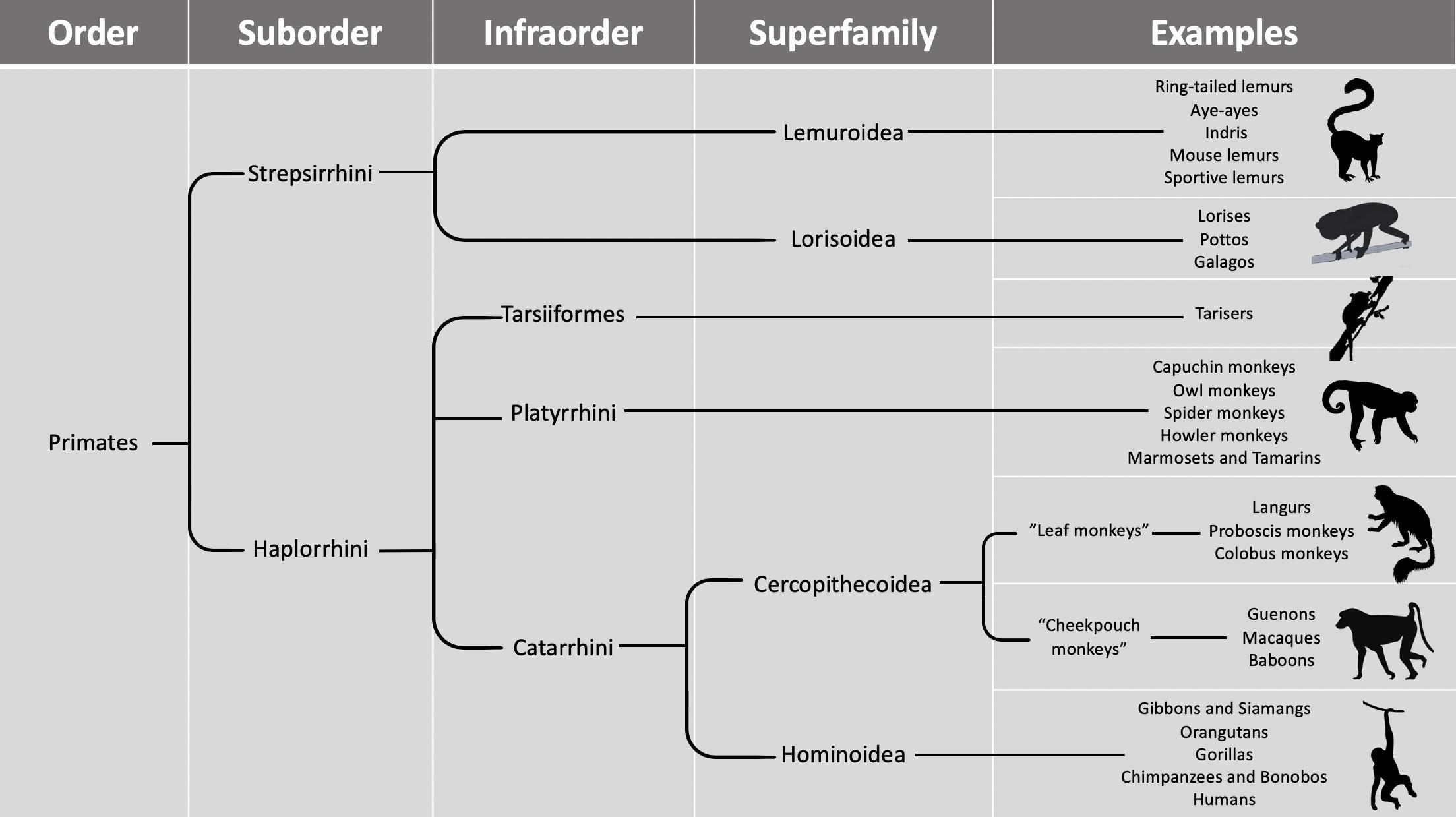
Ways of Organizing Taxa
Our goal in taxonomic classification is to place taxa into categories that reflect their clade relationships. A clade is a grouping of organisms that reflect a branch of the evolutionary tree, a grouping based on relatedness. Clade relationships are determined using derived traits shared by groups of taxa as well as genetic similarities. We are mostly going to refer to the primate groups by their informal names, but you can refer to Figure 9 for the scientific names for their various nested clades.
Lemurs, lorises, and galagos
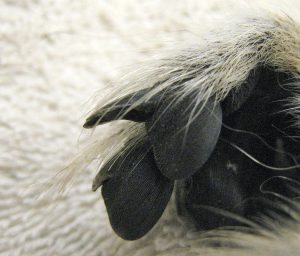
The first group of primates include the species commonly called lemurs, lorises, and galagos. These primates all share two key derived traits: the grooming claw (Figure 10), which is on the second digit of each foot, and the tooth comb (or dental comb), located on the lower, front teeth (Figure 11). They also all retain a long snout and wet nose (like the nose of your dog or cat) – reflecting their greater reliance on olfaction. Indeed, many of these species use scent marking, rubbing scent glands or urine on objects in the environment to communicate with others. Additionally, many primate species in this group have mobile ears that they use to locate insect prey and predators. All lemurs, lorises, and galagos have a tapetum lucidum, a reflective layer at the back of the eye that reflects light and thereby enhances the ability to see in low-light conditions. It is the same layer that causes your dog or cat to have “yellow eye” when you take photos of them with the flash on. It is thought to be primitive among mammals as a whole.
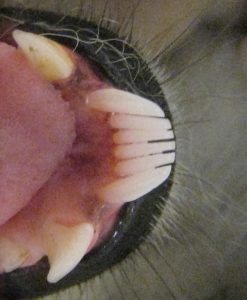
The majority of the species in this group are solitary, traveling alone to search for food, although some taxa are more social. Most are also nocturnal and arboreal, have smaller body sizes, and consume a diet consisting of insects and fruit, with few taxa eating primarily leaves. Lastly, most of these species are good at leaping, including vertical clinging and leaping.
Species in this group can be found all across the Asia, Africa, and on the island of Madagascar (Figure 12).
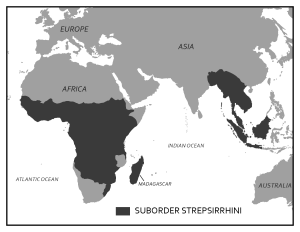
Lemurs of Madagascar
Madagascar is an island off the east coast of Africa, and it is roughly the size of California, Oregon, and Washington combined. It has been separated from Africa for about 130 million years and from India for about 85 million years, which means it was already an island when lemur ancestors got there approximately 60–70 million years ago. Only a few mammal species ever reached Madagascar, and so when lemurs arrived they were able to flourish into a variety of forms.
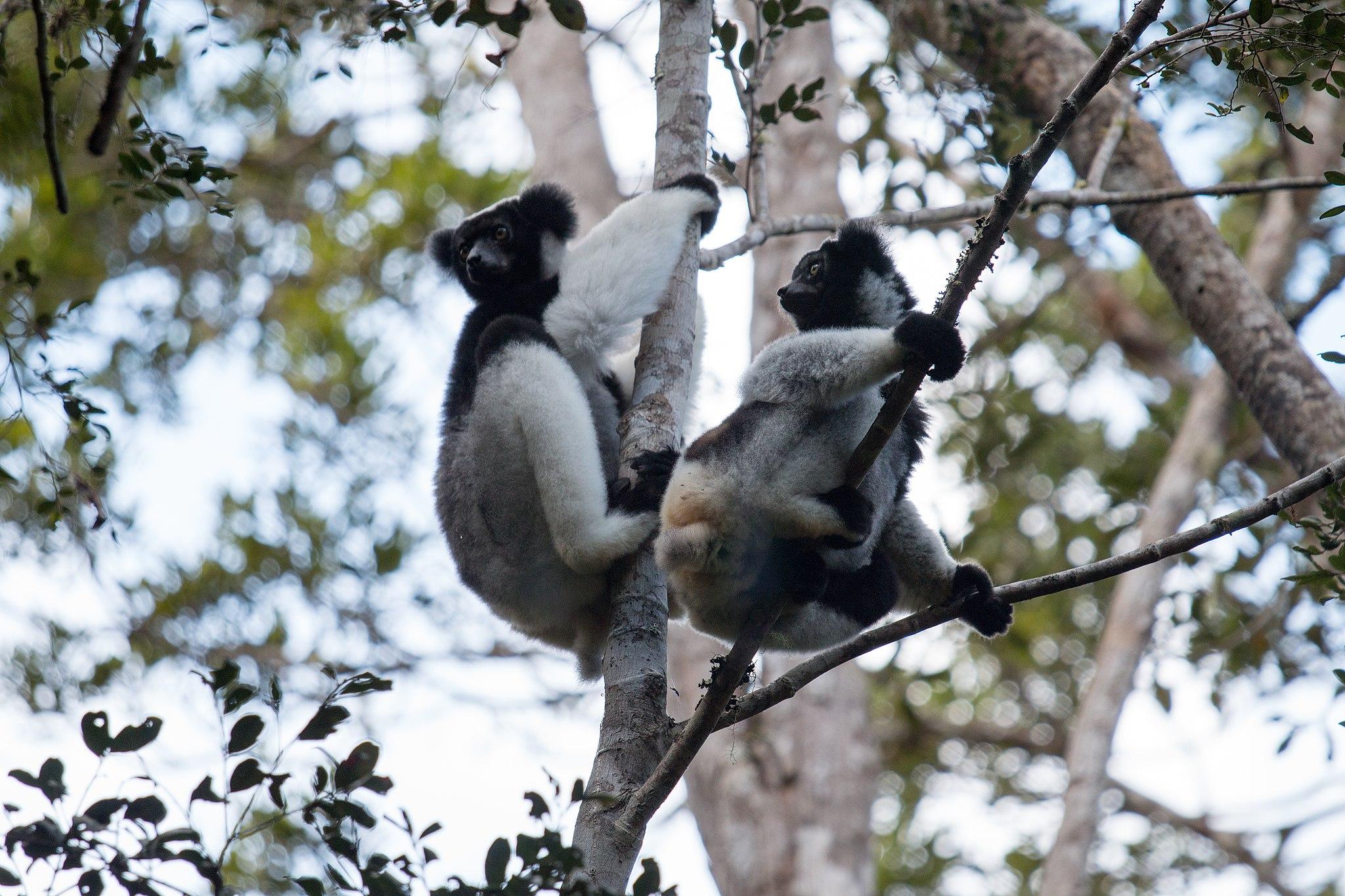
The lemurs of Madagascar are much more diverse compared to their mainland counterparts, the lorises and galagos. While many species are nocturnal, plenty of others are diurnal or cathemeral. They range in body size from the smallest of all primates, the mouse lemur, some species of which weigh a little over an ounce, up to the largest lemur, the indri, which weighs up to about 20 pounds (Figure 13). Lemurs include species that are insectivorous, frugivorous, and folivorous. A couple of members of this group have specialized in more unusual diets for primates. These include the gummivorous fork-marked lemurs as well as bamboo lemurs, who are able to metabolize the cyanide in bamboo. The most unusual lemur is the aye-aye. This nocturnal lemur exhibits traits not seen in any other primate, including having rodent-like front teeth that grow continuously and a long-bony middle finger that it uses to fish grubs out of wood. It has a very large brain compared to other lemurs, which it fuels with a diet that includes bird’s eggs and other animal matter. Based on genetic estimates and morphological studies, it is believed that aye-ayes were the first lemurs to separate from all of the other strepsirrhines and so have been evolving on their own since around the time strepsirrhines got to Madagascar (Matsui et al. 2009).
Lemurs are also diverse in terms of behavior. Many are solitary foragers, but some live in pairs, others in small groups, some in larger groups, and some, like the red-ruffed lemur, are now known to live in complex social groups that are unlike what we see in any other primates. It is also among the lemurs that we see some of the best vertical clingers and leapers. Many lemurs are quadrupedal, but even the quadrupedal lemurs are quite adept at leaping. Malagasy strepsirrhines also exhibit a few unusual traits. They are highly seasonal breeders, often mating only during a short window, once a year. Female ring-tailed lemurs, for example, only come into estrus one day a year for a mere six hours. Lemurs are also unusual in that females are socially dominant. In most primates, males dominate females because they are typically larger and exhibit greater aggression, but in lemur groups, males and females are usually the same size and females have priority access to resources over males.
Lorises, Pottos, and Galagos of Asia and Africa
Unlike the lemurs of Madagascar, lorises, pottos, and galagos live in areas where they share their environments with monkeys and apes, who often eat similar foods. Lorises live across South and Southeast Asia, while pottos and galagos live across Central Africa. Because of competition with larger-bodied monkeys and apes, mainland lorises, pottos, and galagos are more restricted in the niches they can fill in their environments and so are not as diverse as the lemurs of Madagascar.
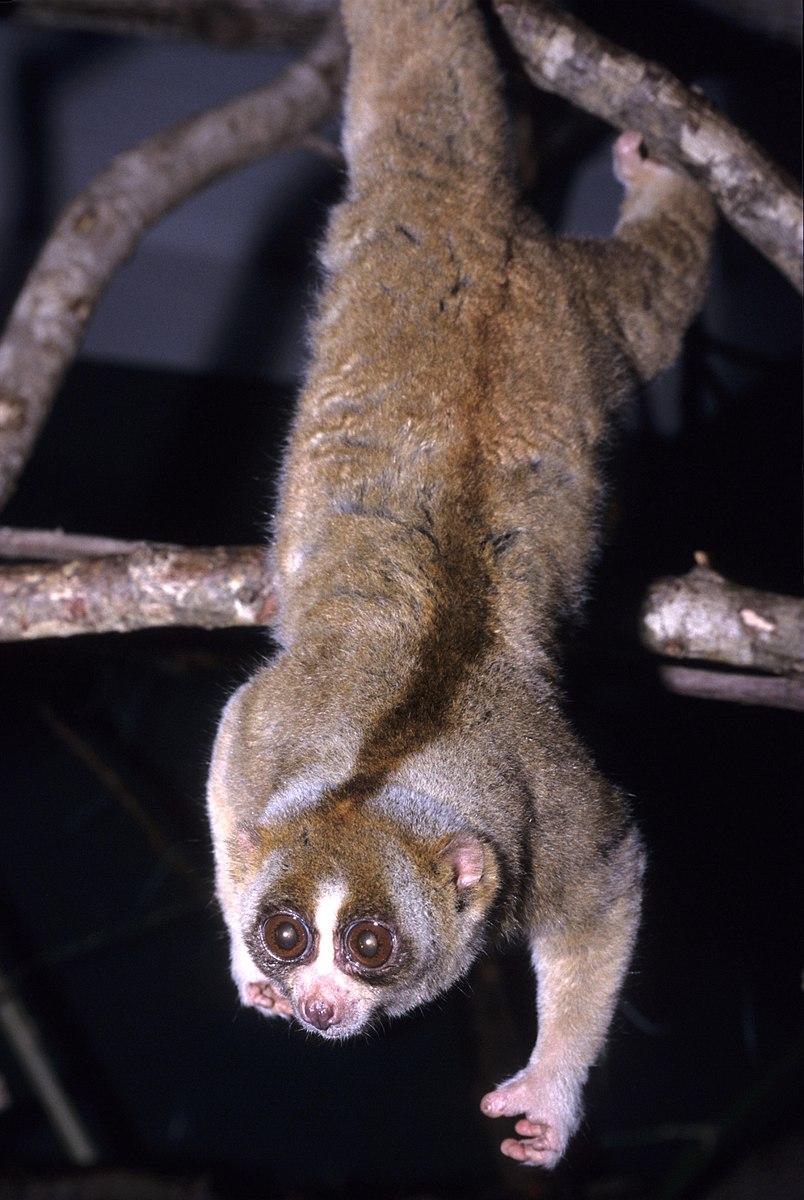
All species in Africa and Asia are nocturnal and solitary. Their body sizes don’t range as greatly as the lemurs, and neither do their diets. For the most part, the diet of lorises, pottos, and galagos consist of fruits and insects. A couple of species eat more gum, but overall the diet of this group is fairly narrow when compared to the Malagasy lemurs. Lorises and pottos are known for being slow, quadrupedal climbers, moving quietly through the forests to avoid being detected by predators (Figure 14). Because they are not fast moving, they have developed alternative defenses against predators. Lorises, for example, eat a lot of caterpillars, which makes their saliva slightly toxic. Loris mothers will then bathe their young in this toxic saliva, thus making the babies unappealing to predators. In comparison to the slow-moving lorises and pottos, galagos are active quadrupedal runners and leapers that scurry about the forests at night. Galagos make distinctive calls that sound like a baby crying, which has led to their nickname “bushbabies.” The chart below summarizes the key differences between the lemurs of Madagascar and the lorises, galagos, and pottos of Africa and Asia.
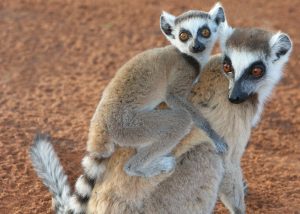
Lemurs |
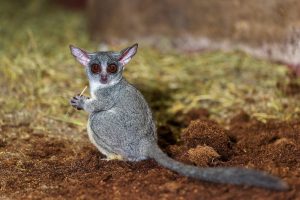
Lorises, Pottos and Galagos |
|
| Geographic range | Madagascar | South and Southeast Asia and Central Asia |
| Activity patterns | Diurnal, nocturnal or cathemeral | Nocturnal |
| Dietary types | Insectivore, frugivore or folivore | Insectivore, frugivore |
| Social groupings | Solitary, pairs, or small to large groups | Solitary |
| Forms of locomotion | Vertical clinger leapers, quadrupedal | Slow quadrupedal climbers and active quadrupedal runners |
Tarsiers, monkeys, and apes
The group in including tarsiers, monkeys, and apes shares many derived traits. Their visual systems are more developed, and many are trichromatic. With one exception, they all have full postorbital closure (Figure 1), and more convergent convergent eyes. The heavier reliance on vision over olfaction is also reflected in their shorter snouts ending with a dry nose. All but two genera in this group are active during the day, so they lack the tapetum lucidum which is so useful to nocturnal species. On average, they also have larger brains relative to their body size when compared with lemurs, lorises, and galagos.
This group of primates is generally larger than lemurs and lorises, and so we see many more species that are folivorous and frugivorous, and fewer that are insectivorous. The larger body size of this group also influences locomotion. Only one member is a vertical clinger and leaper; most are quadrupedal, with one subgroup specialized for brachiation. Many members of this group show moderate to high sexual dimorphism in body size and canine size. All but two species live in groups, which is very different from the primarily solitary lemurs and lorises. Differences between the two suborders are summarized in the chart below.
|
Lemurs, lorises, and galagos |
Tarsiers, monkeys, and apes |
|
|
Sensory adaptations |
Wet nose Longer snout Eyes less convergent Post-orbital bar Tapetum lucidum Mobile ears |
Dry nose Short snout Eyes more convergent Post-orbital plate No tapetum lucidum Many are trichromatic |
|
Dietary differences |
Mostly insectivores and frugivores, few folivores |
Few insectivores, mostly frugivores and folivores |
|
Activity patterns and Ecology |
Mostly nocturnal, few diurnal or cathemeral Almost entirely arboreal |
Only two are nocturnal, rest are diurnal Many arboreal taxa, also many terrestrial taxa |
|
Social groupings |
Mostly solitary, some pairs, small to large groups |
Only two are solitary, all others live in pairs, small to very large groups |
|
Sexual dimorphism |
Minimal to none |
Few taxa have little/none, many taxa show moderate to high dimorphism |
This larger group is divided into three smaller groups based on shared characteristics: Tarsiiformes, which includes the tarsiers of Asia; Platyrrhini, which includes the monkeys of Central and South America; and Catarrhini, a group that includes the monkeys and apes of Asia and Africa, as well as humans. According to molecular estimates, tarsiers split from the other groups close to 70 million years ago, and platyrrhini split from catarrhini close to 46 million years ago (Pozzi et al. 2014).
Tarsiers of Asia
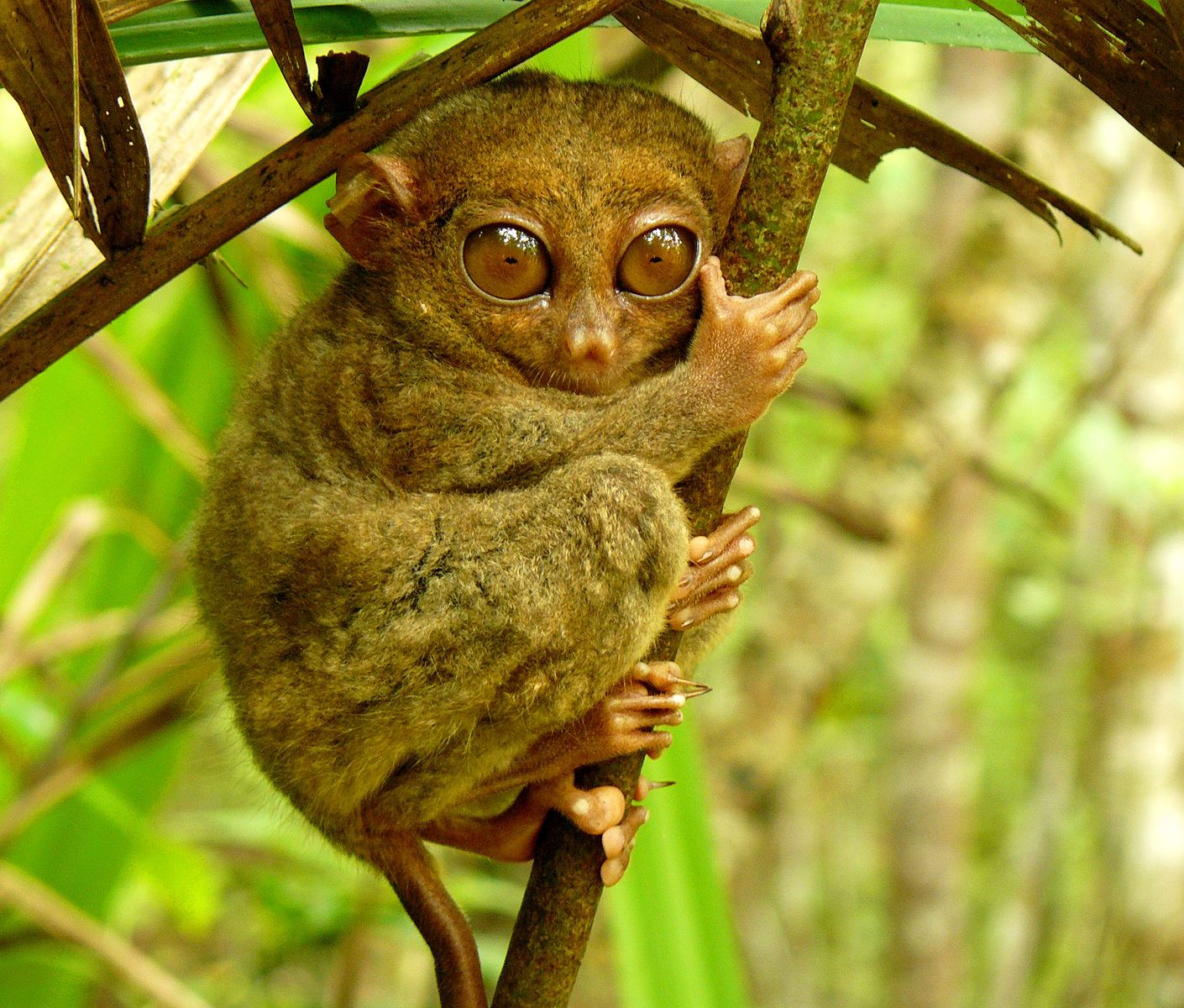

Today, this group includes only one genus, Tarsius (Figure 15). Tarsiers are small-bodied primates that live in Southeast Asian forests (Figure 16) and possess an unusual collection of traits that have led to some debate about their position in the primate taxonomy. They share several key derived traits with monkeys, apes, and humans, including dry noses, not having a tapetum lucidum, and having eyes that are close together. Tarsiers also have some traits that are more like lemurs and lorises and some that are unique. Tarsiers are the only member of their group that are specialized vertical clinger leapers. Tarsiers actually get their name because their ankle (tarsal) bones are elongated to provide a lever for vertical clinging and leaping. Tarsiiformes are also small, with most species weighing between 100 and 150 grams. Like lemurs and lorises, tarsiers are nocturnal, but because they lack a tapetum lucidum, tarsiers compensate by having enormous eyes. In fact, each eye of a tarsier is larger than its brain. These large eyes allow enough light in for tarsiers to still be able to see well at night without the reflecting layer in their eyes. To protect their large eyes, tarsiers have a partially closed postorbital plate that is somewhat intermediate between the postorbital bar of lemurs and the full postorbital closure of monkeys and apes. Other unusual traits of tarsiers include having two grooming claws on each foot and the ability to rotate their heads around 180 degrees, a trait useful in locating insect prey. The tarsier diet consists entirely of animal matter, making them the only primate not to eat any vegetation. They are also only one of two living members of this group to be solitary, the other being the orangutan. Most tarsiers are not sexually dimorphic, although males of a few species are slightly larger than females.
Some scientists have argued about the best way to classify tarsiers because of the types of characteristics they share with lemurs, lorises, monkeys, and apes, but today most classification schemes group them with monkeys and apes. This is based on the interpretation that their shared derived characteristics suggest that they are most closely related to monkeys and apes.
Central and South American Monkeys
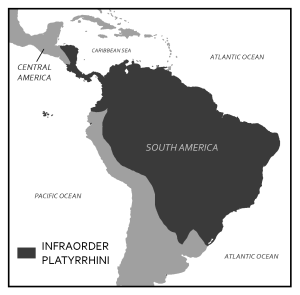
Central and South American monkeys are the only non-human primates in Central and South America (Figure 17) and so, like the lemurs of Madagascar, have diversified into a variety of forms in the absence of competition. Their noses that are flat and wide, with nostrils that are far apart, facing outward, and usually round in shape (Figure 18). This nose shape is very different from what we see in African and Asian monkeys, apes, and humans.
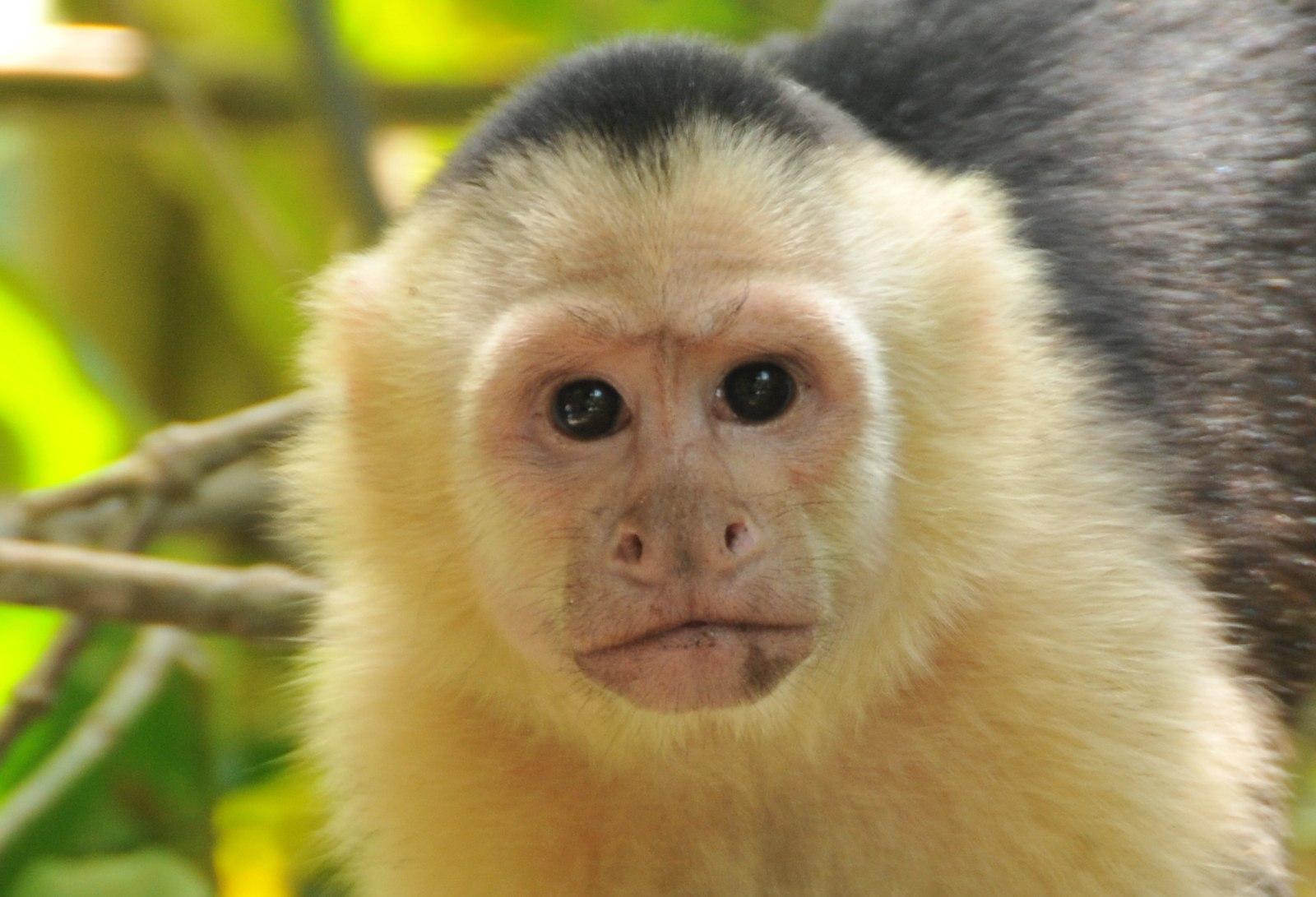
On average, Central and South American monkeys are smaller and less sexually dimorphic than African and Asian monkeys and apes. Central and South American monkeys are also all highly arboreal, whereas many African and Asian monkeys and apes spend significant time on the ground. The Central and South American monkeys monkeys also differ in having less well-developed vision. This is reflected in the wiring in the visual system of the brain but also in their polymorphic color vision. The genes that enable individuals to distinguish reds and yellows from blues and greens are on the X chromosome. Different genes code for being able to see different wavelengths of light so to distinguish between them you need to be heterozygous for seeing color. In Central and South American monkeys, each X chromosome carries the genes for seeing one wavelength. This means that male monkeys (having only one X chromosome) are always dichromatic. Female monkeys in Central and South America can be dichromatic (if they are homozygous for the same version of the color vision gene) or trichromatic (if they are heterozygous). We currently know of only two exceptions to this pattern among Central and South American monkeys. Owl monkeys, which are nocturnal, cannot distinguish any colors. The other exception are Howler monkeys, which have evolved to have two color vision genes on each X chromosome. This means that both male and female howler monkeys are able to see reds and yellows. As we will discuss, all African and Asian monkeys, apes, and humans are trichromatic.
Central and South American monkeys include the smallest of the monkeys, the marmosets and tamarins (Figure 19). These small monkeys, all of which weigh less than 1 kilogram, live in cooperative family groups, wherein usually only one female reproduces and everyone else helps carry and raise the offspring. They are unusual primates in that they regularly produce twins. The diet of marmosets and tamarins largely consists of gums and saps, so these monkeys have evolved claw-like nails that enable them to cling to the sides of tree trunks like squirrels as well as special teeth that allow them to gnaw through bark.
The largest of the Central and South American monkeys are a family that include spider monkeys, woolly spider monkeys, woolly monkeys, and howler monkeys (Figure 20). This group of monkeys can weigh up to 9–15 kg and have evolved prehensile tails that can hold their entire body weight. It is among this group that we see semi-brachiators, like the spider monkey (Figure 8). To make them more efficient in this form of locomotion, spider monkeys evolved to not have thumbs so that their hands work more like hooks that can easily let go of branches while swinging. Howler monkeys are another well-known member of this group, earning their name due to their loud calls, which can be heard for miles away. To make these loud vocalizations, howler monkeys have a specialized vocal system that includes a large larynx and hyoid bone. Howler monkeys are the most folivorous of the Central and South American monkeys and are known for spending a large portion of their day digesting their food.
There are many other monkeys in the Central and South America, including the gregarious capuchins (Figure 18) and squirrel monkeys, the pair-living titi monkeys, and the nocturnal owl monkeys. There are also the seed-eating monkeys such as saki monkeys and uakaris. In many areas across Central and South America, multiple different species of monkey will share the forests, and some species will even travel together in associations. According to molecular evidence, the diversity of Central and South American monkeys that we see today seems to have originated about 25 million years ago (Schneider and Sampaio 2015).
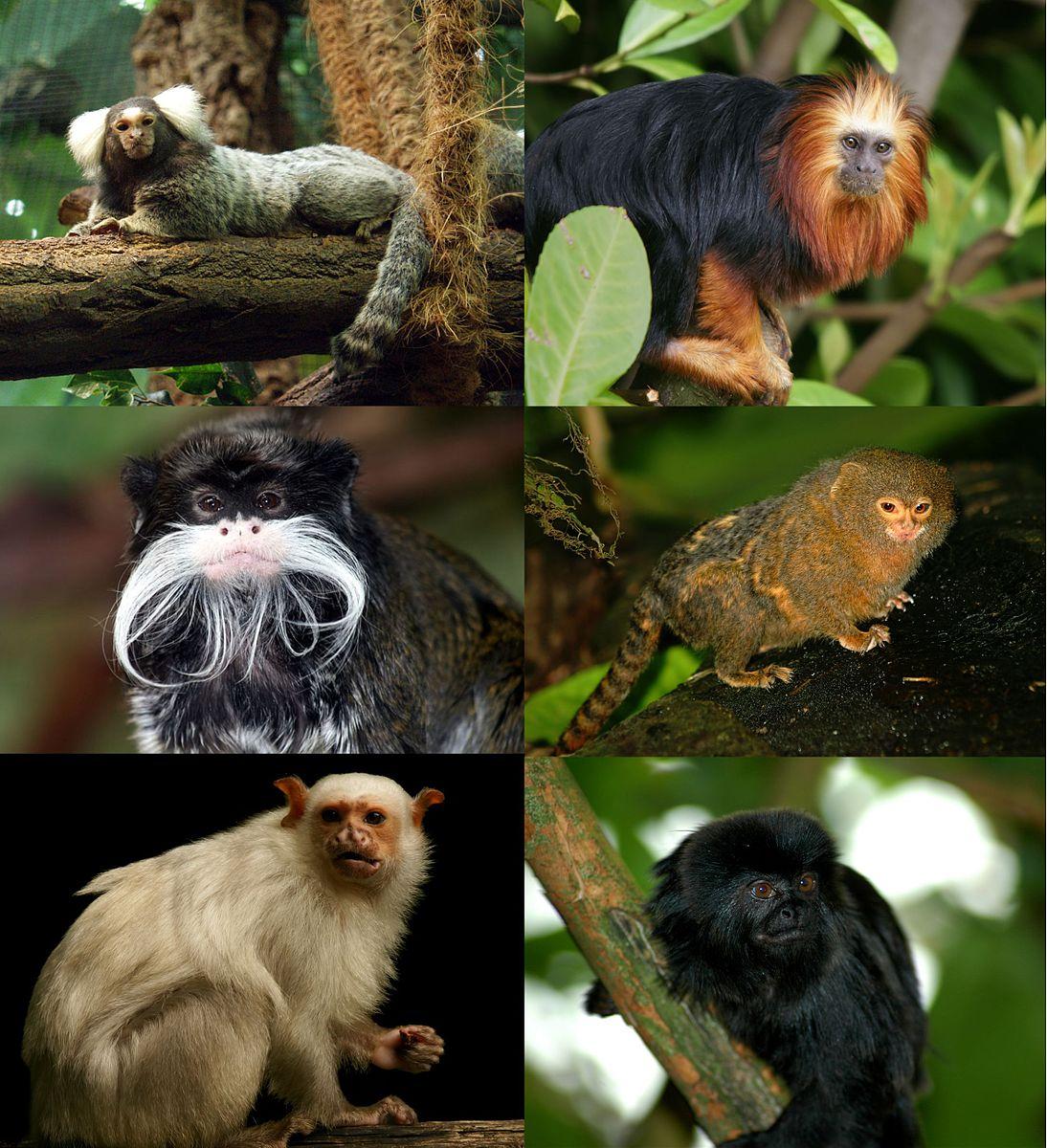
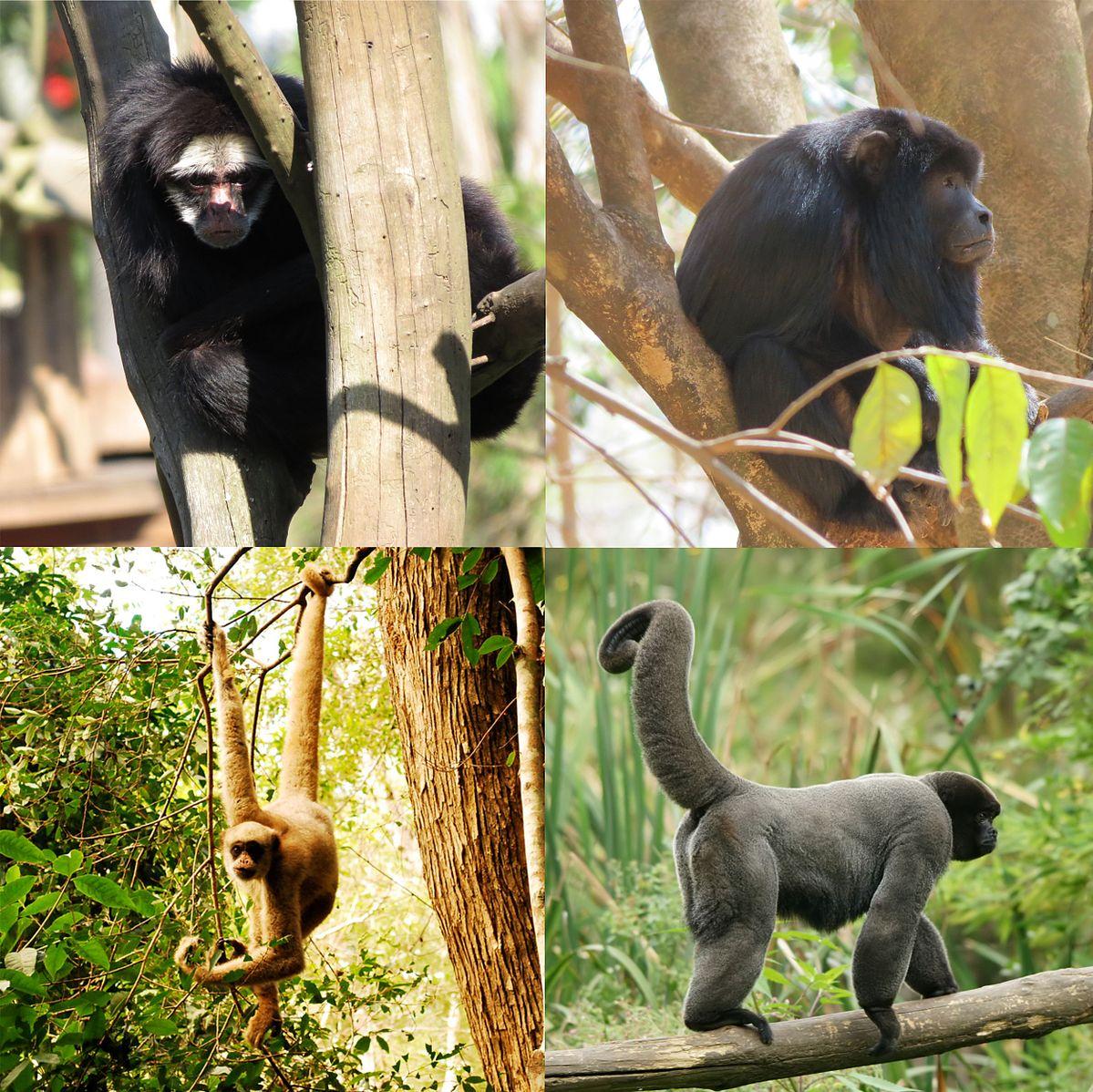
Monkeys and apes of Asia and Africa
Non-human members of this group are found all over Africa and South and Southeast Asia, with some being found as far north as Japan. The most northerly and southerly distributed species are monkeys. In contrast, apes are less tolerant of drier, more seasonal environments and so have a relatively restricted geographic range.
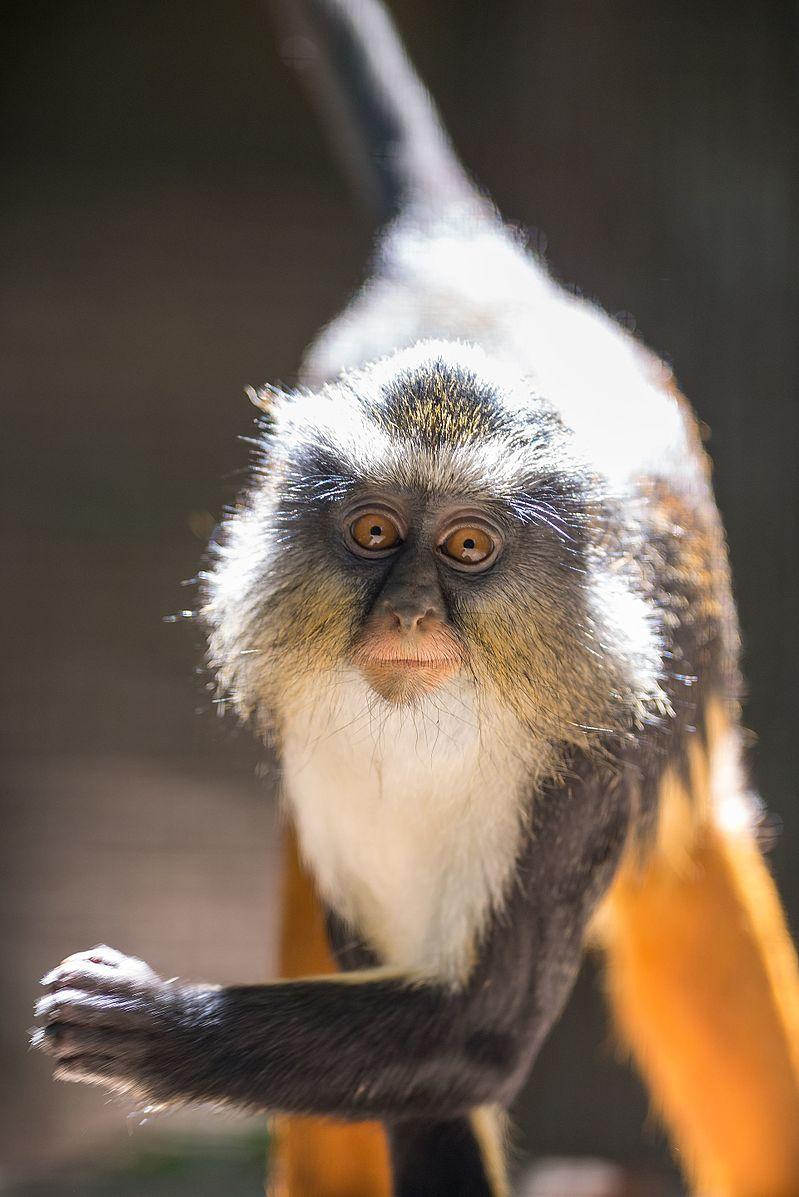
African and Asian monkeys and apes have a distinctive nose shape, with teardrop-shaped nostrils that are close together and point downward (Figure 21). On average, African and Asian monkeys and apes are the largest and most sexually dimorphic group of primates. Gorillas are the largest of all living primates, with males weighing up to 220 kg. The most sexually dimorphic of all primates are mandrills. Mandrill males not only have much more vibrant coloration than mandrill females but also have larger canines and can weigh up to three times more. The larger body size of African and Asian monkeys and apes is related to the more terrestrial lifestyle of many members of this group. In fact, the most terrestrial of living primates can be found in this group. Among all primate taxa, vision is the most developed in African and Asian monkeys and apes. They independently evolved the same adaptation as howler monkeys in having each X chromosome with sufficient genes to distinguish both reds and yellows, so all African and Asian monkeys and apes are trichromatic. Trichromatic color vision is particularly useful to this group because they are all diurnal.
This group is divided into two superfamilies: monkeys and hominoids (apes including humans). Molecular estimates place the split between African and Asian monkeys and apes at about 32 million years ago (Pozzi et al. 2014).
Monkeys of Africa and Asia
Compared to hominoids, African and Asian monkeys have a more primitive quadrupedal body plan, but they do have a couple of derived traits shared by all members of this group. All African and Asian monkeys have bilophodont molars (“bi” meaning two, “loph” referring to ridge, and “dont” meaning tooth). It is thought that this molar enabled African and Asian monkeys to eat a wide range of foods, thus allowing them to live in habitats that apes cannot. The other key derived trait that all African and Asian monkeys share is having ischial callosities (Figure 22). The ischium is the part of your pelvis that you are sitting on right now. In African and Asian monkeys, this part of the pelvis has a flattened surface that, in living animals, will have callused skin over it. These function as seat pads for these monkeys, who often sit above branches or on hot or sharp rocks when feeding and resting.
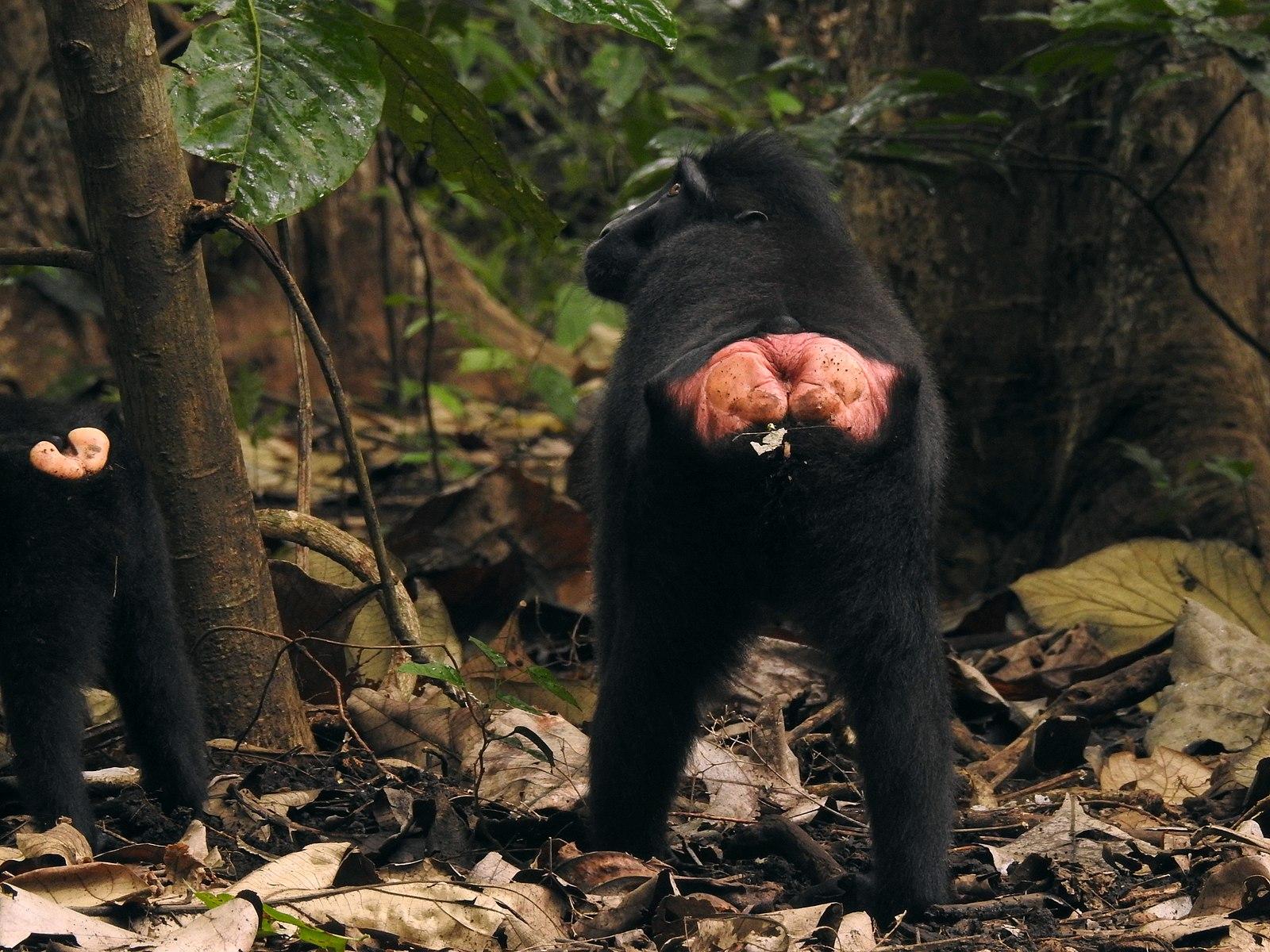

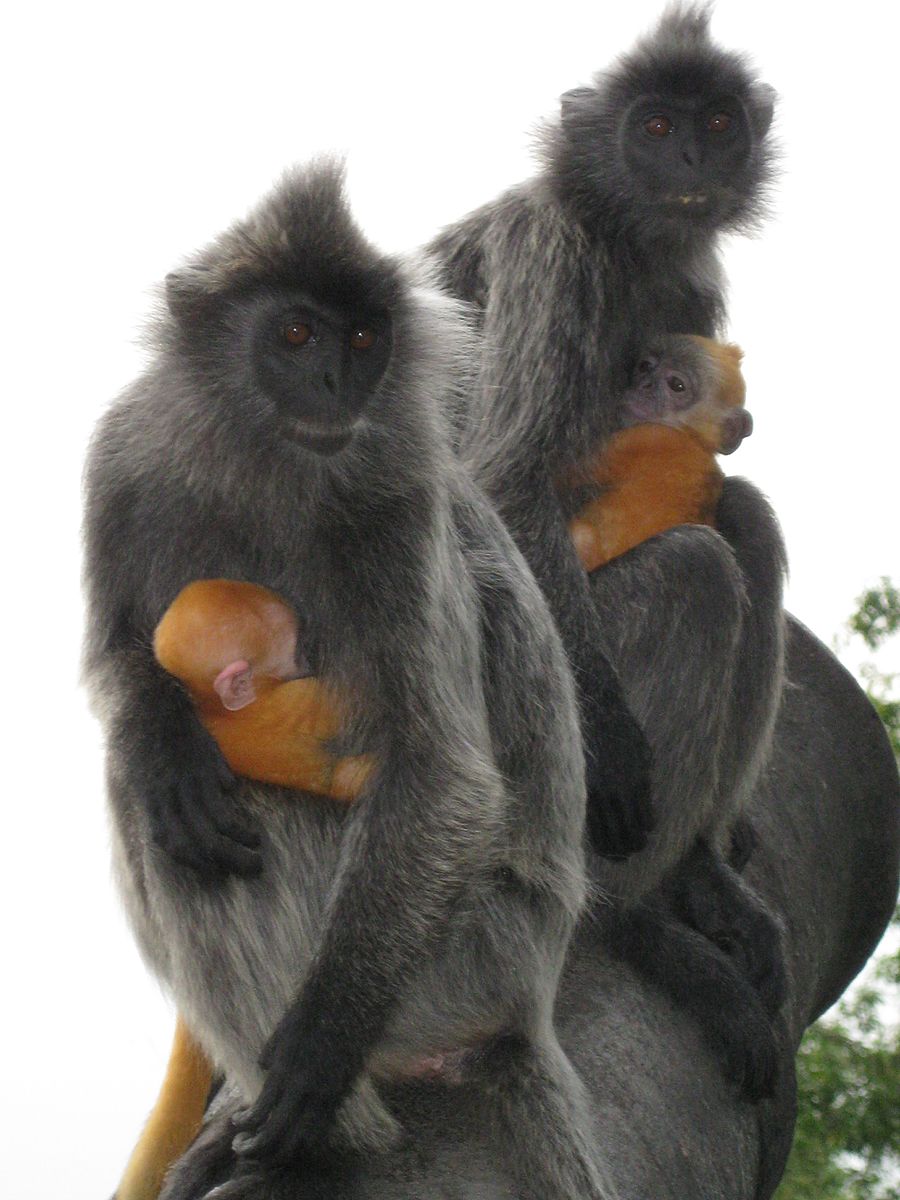
The African and Asian monkeys are the most geographically widespread group of non-human primates (Figure 23). Since their divergence from hominoids, this monkey group has increased in numbers and diversity. In part, their success over hominoids is due to the faster reproductive rates of monkeys relative to hominoids. On average, African and Asian monkeys will reproduce every one to two years, whereas hominoids will reproduce once every four to nine years, depending on the taxon.
There are two groups of African and Asian monkeys: the leaf monkeys and the cheek-pouch monkeys. Both groups coexist in Asia and Africa; however, the majority of leaf monkey species live in Asia with only a few taxa in Africa. In contrast, only one genus of cheek-pouch monkey lives in Asia, and all the rest of them in Africa. As you can probably guess based on their names, the two groups differ in terms of diet. Leaf monkeys are primarily folivores, with some species eating a significant amount of seeds. Cheek-pouch monkeys tend to be more frugivorous or omnivorous, with one taxon, geladas, eating primarily grasses. The two groups also differ in some other interesting ways. Leaf monkeys tend to produce infants with natal coats—infants whose fur is a completely different color from their parents (Figure 24). Leaf monkeys are also known for having odd noses, and so they are sometimes called “odd-nosed monkeys.” Cheek-pouch monkeys are able to pack food into their cheek pouches (Figure 25), thus allowing them to move to a location safe from predators or aggressive individuals of their own species where they can eat in peace.
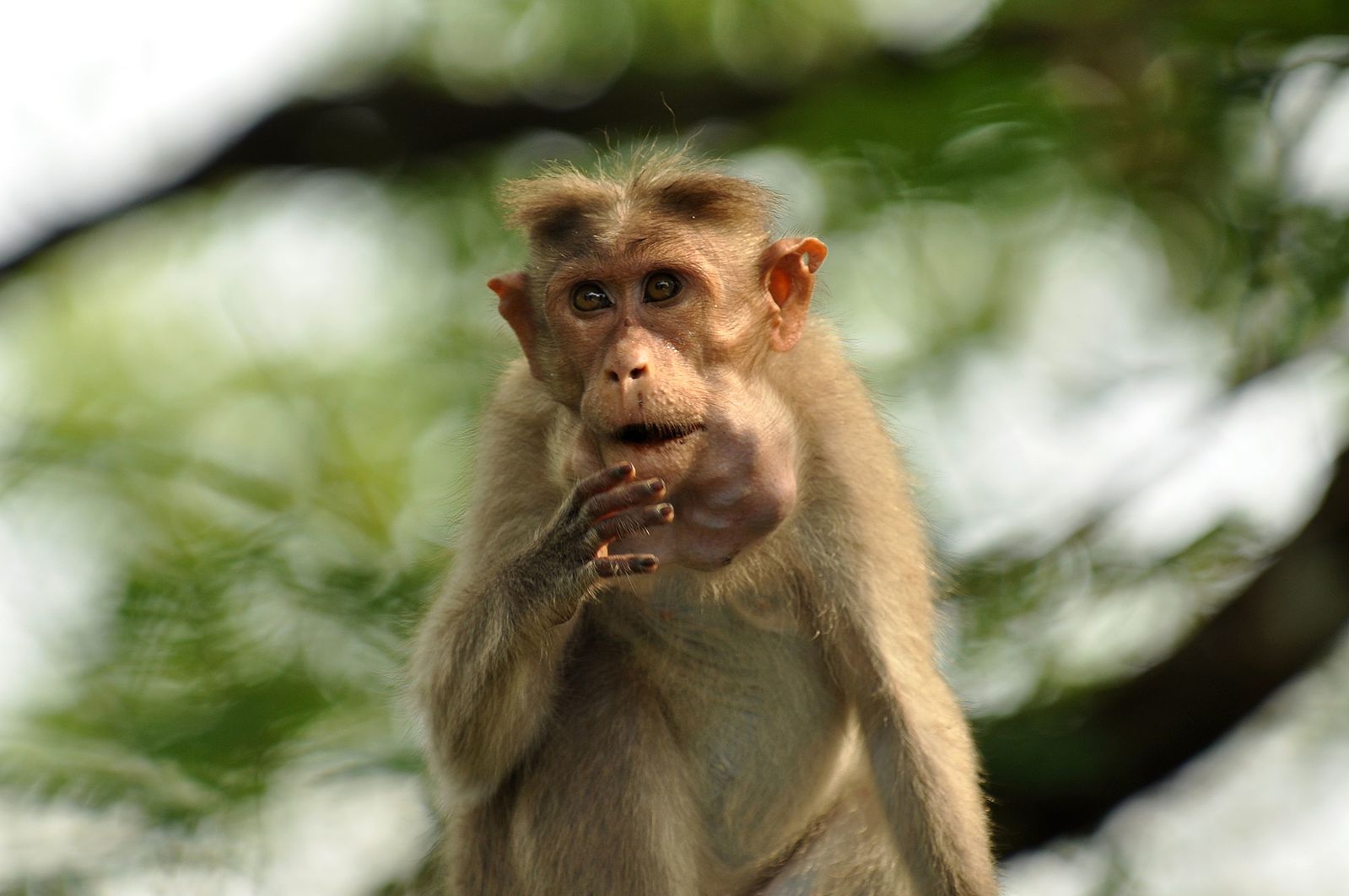
Apes and Humans of Africa and Asia
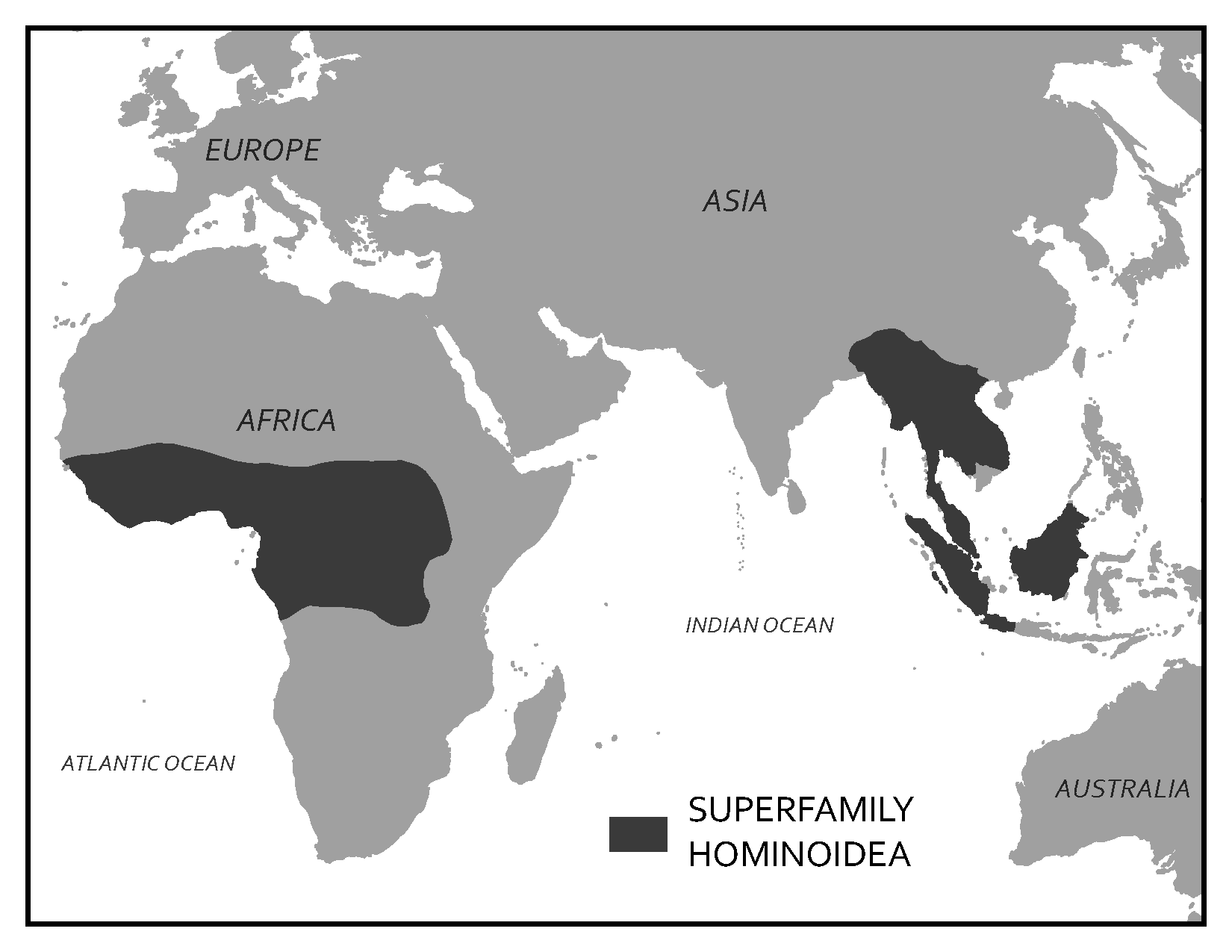
The Hominoidea of Africa and Asia (Figure 26) includes the largest of the living primates, apes and humans, but our superfamily differs from other primates in some other key ways as well. When compared to African and Asian monkeys, hominoids have more primitive teeth. Where hominoids differ the most from other primates, however, is in our body plans. This is due to the unusual form of locomotion that hominoids are adapted for, brachiation.
To successfully swing below branches, many changes to the body needed to occur. The arms of a hominoid are much longer than the legs in order to increase reach, and the lower back is shorter and less flexible to increase control when swinging. The torso, shoulders, and arms of hominoids have evolved to increase range of motion and flexibility. The clavicle, or collar bone, is longer in order to stabilize the shoulder joint out to the side, thus enabling us to rotate our arms 360 degrees. Our rib cages are wider side to side and shallower front to back than those of monkeys and we do not have tails, as tails are useful for balance when running on all fours but not useful when swinging.
Apes and humans also differ from other primates in behavior and life history characteristics (see chart below). Hominoids are characterized by the most extended life histories of all primates. All members of this group live a long time and take a long time to grow and start reproducing. Hominoids also reproduce much less frequently compared to African and Asian monkeys. The slow pace of this life history is likely related to why hominoids have decreased in diversity since they first evolved. In the past, hominoids were tremendously diverse in both geography and adaptations. Today, there are only five types of hominoids left: gibbons and siamangs, orangutans, gorillas, chimpanzees and bonobos, and humans.
| African and Asian monkeys and apes |
|
Downward facing, tear-drop shaped nostrils, close together Arboreal and more terrestrial taxa On average, largest primates On average, most sexually dimorphic taxonomic group All trichromatic |
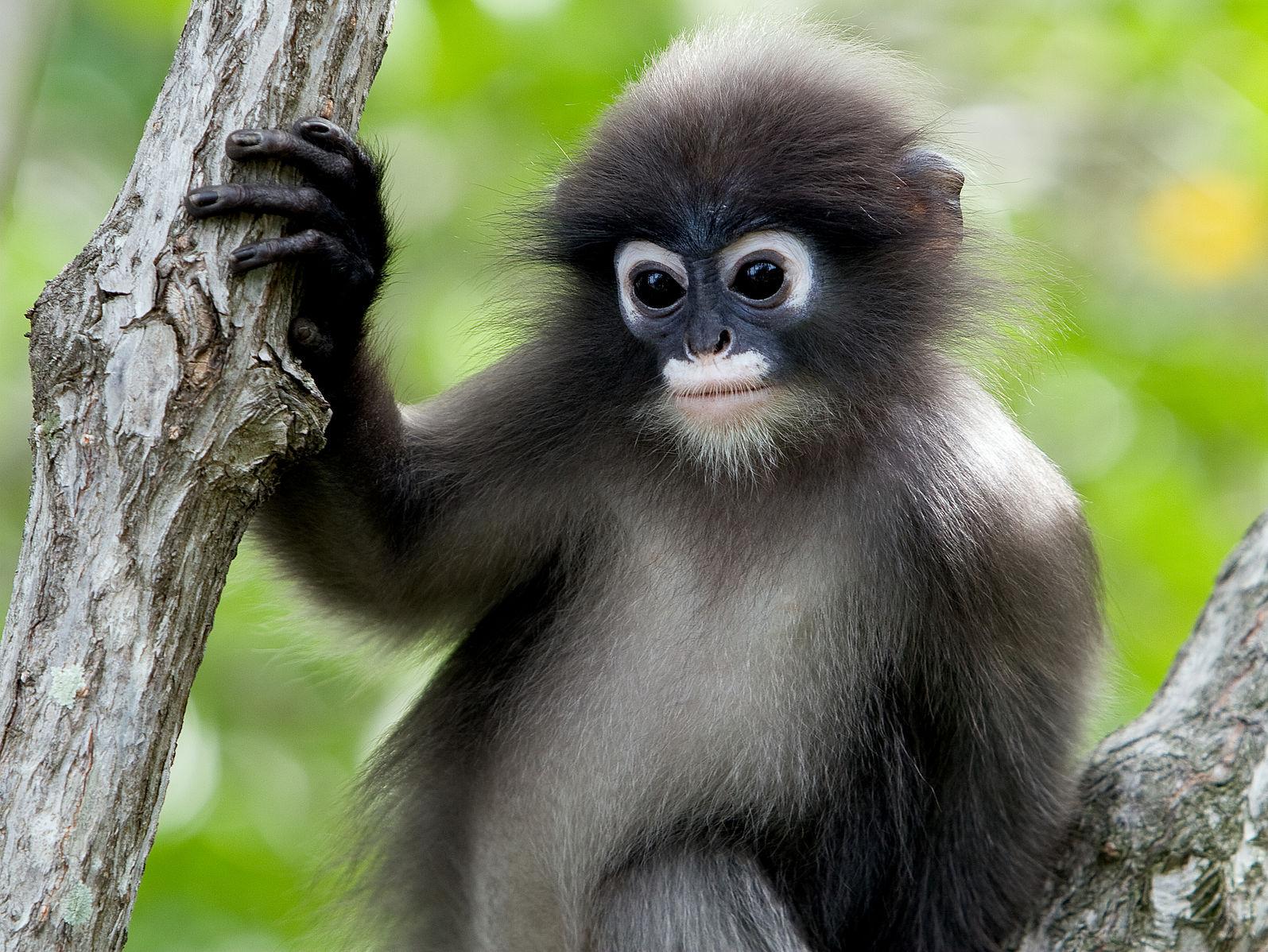
African and Asian monkeys |
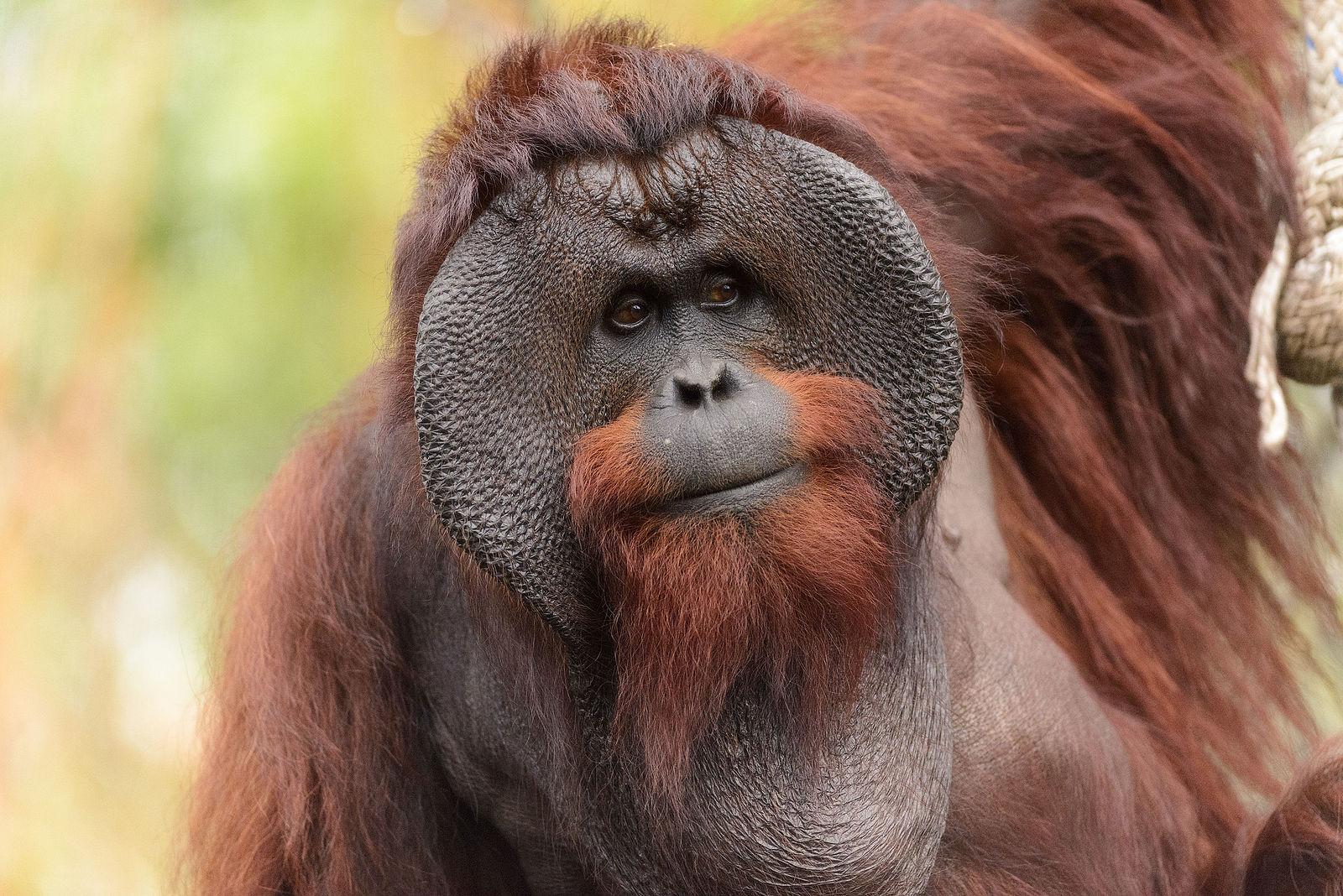
Hominoids (apes) |
|
Wide geographic distribution Bilophodont molars Ischial callosities Reproduce every 1-2 years |
Tropical forests of Africa and Asia More primitive molars Adaptations for brachiation Reproduce every 4-9 years |
Gibbons and Siamangs of Southeast Asia
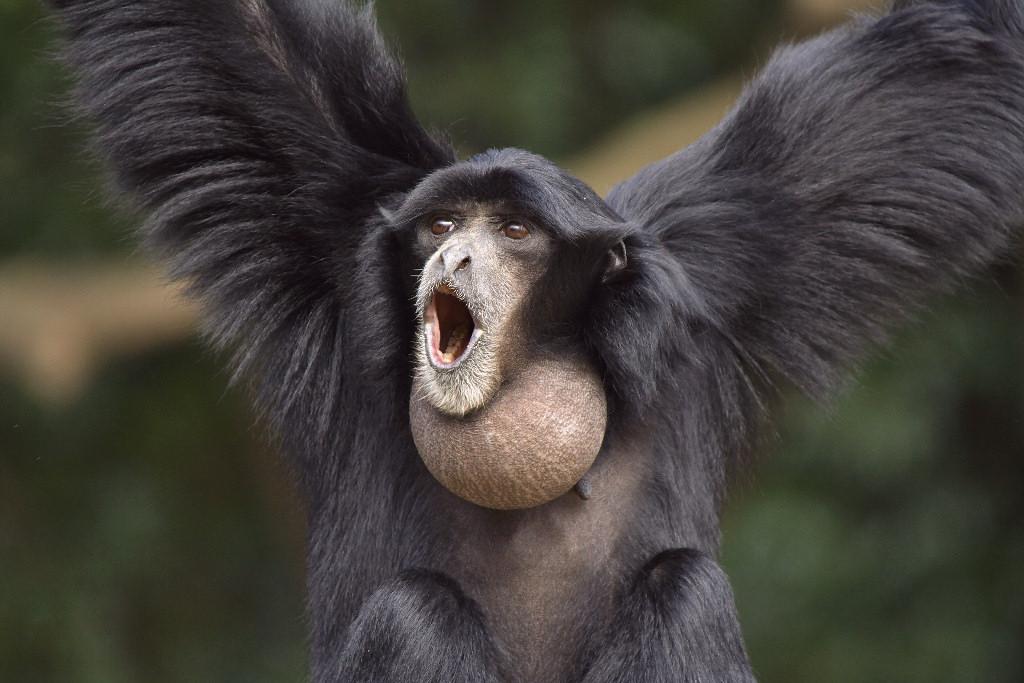
Both gibbons and siamangs are found across Southeast Asian tropical forests. These are the smallest of the hominoids and so are sometimes referred to as the “lesser apes.” Gibbons weigh, on average, about 13 pounds and tend to be more frugivorous, whereas siamangs are about twice the size of gibbons and are more folivorous. Unlike the larger-bodied apes (orangutans, chimps, bonobos, and gorillas) who make nests to sleep in every night, gibbons and siamangs will develop callused patches on their ischium resembling ischial callosities. There are many different gibbon species that vary in their coloration and markings. Siamangs, however, are all black with big throat sacs that are used in their exuberant vocalizations (Figure 27). Both gibbons and siamangs live in pairs with very little sexual dimorphism, although males and females do differ in coloration in some species.
Pongo of Southeast Asia
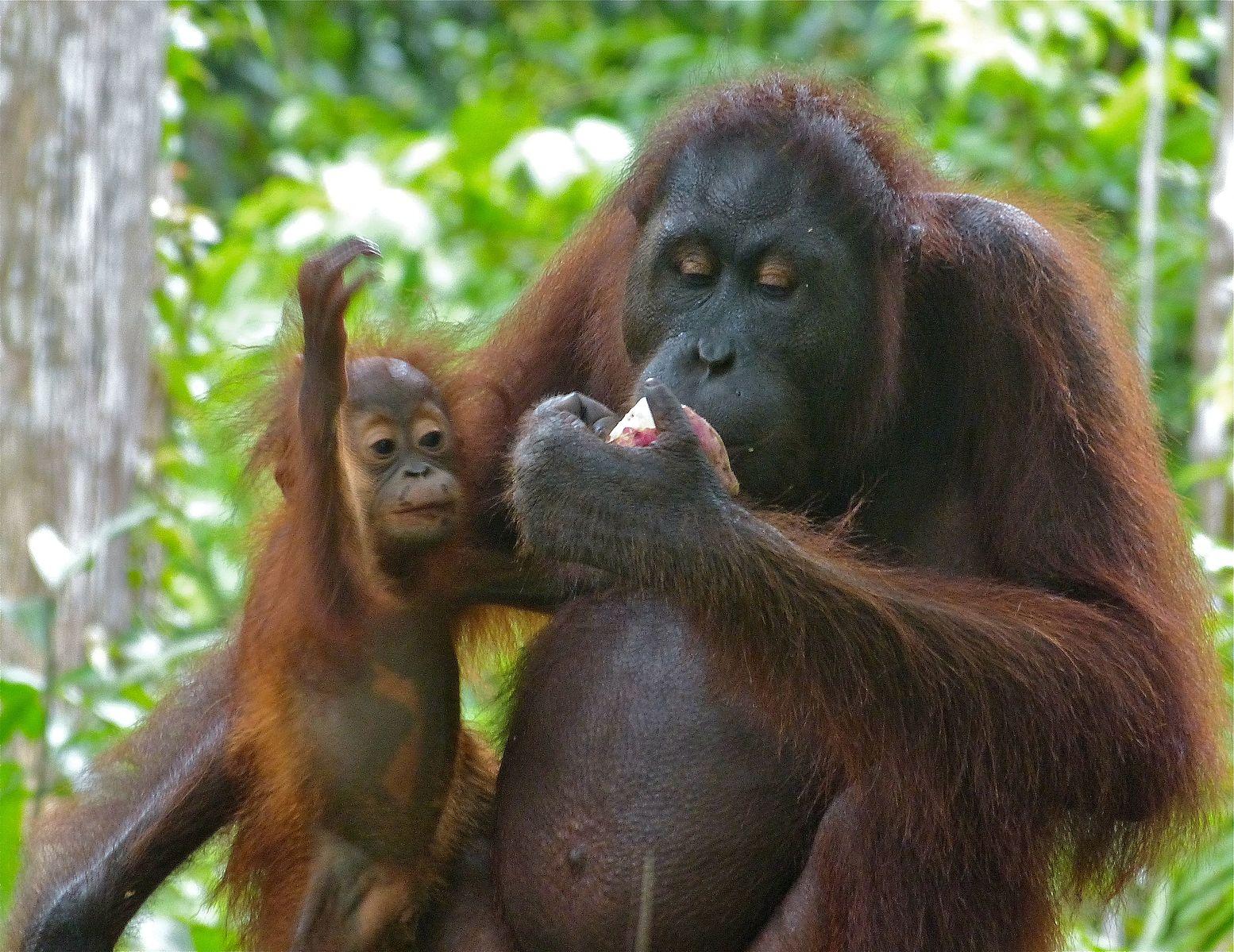
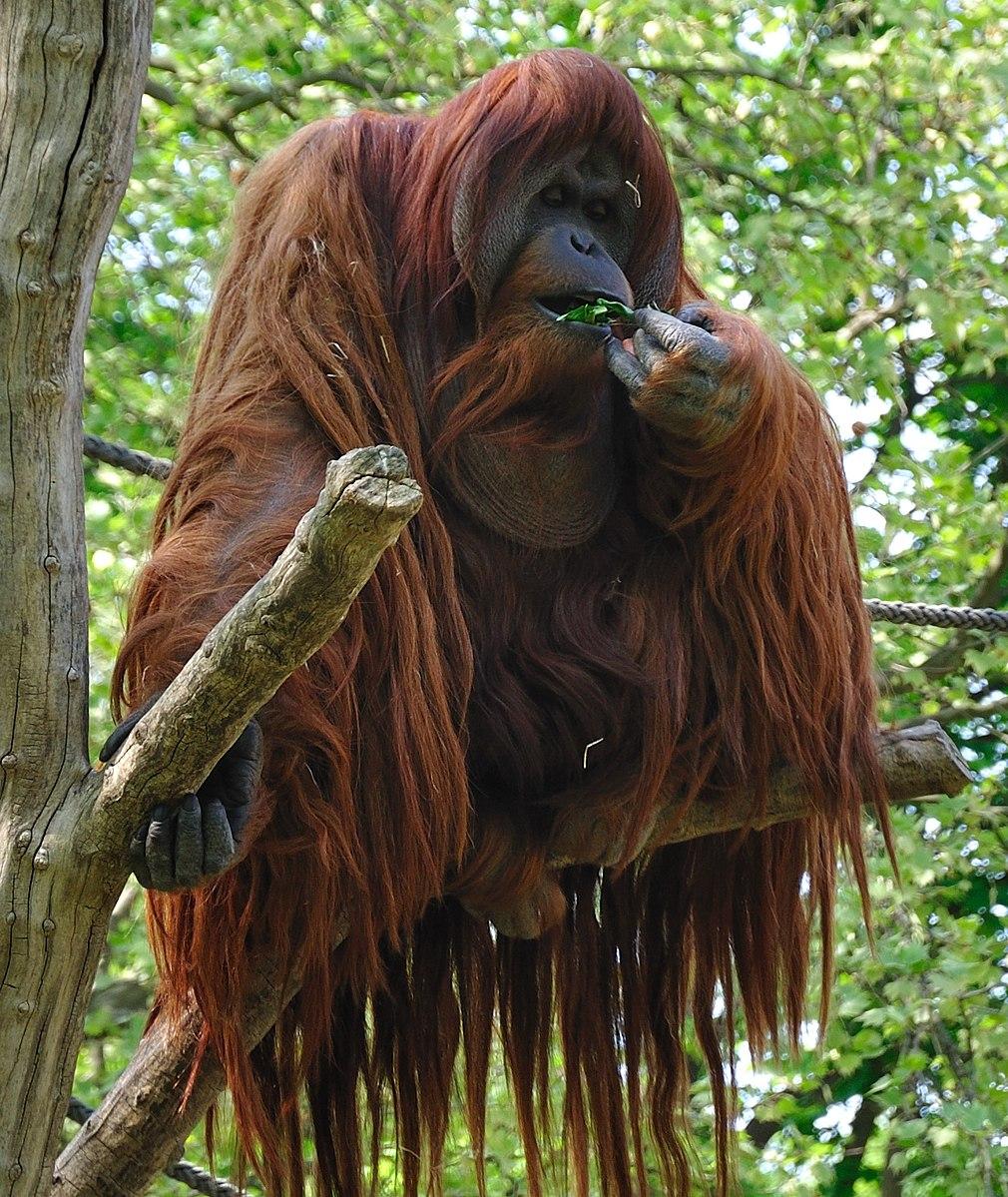
The Genus Pongo refers to orangutans. These large red apes are found on the islands of Borneo and Sumatra in Southeast Asia. There are two well-known species of orangutan, one on each island. Recently, a third, very rare species was discovered in Southern Sumatra (Nater et al. 2017). Orangutans are highly frugivorous but will supplement their diet with leaves and even bark when fruit is less available. Orangutans are the only diurnal, solitary taxon among primates and are extremely slow to reproduce, producing only one offspring about every seven to nine years. They are highly sexually dimorphic (Figures 28 and 29), with fully developed, “flanged” males being approximately twice the size of females. These males have large throat sacs; long, shaggy coats; and cheek flanges.The skulls of male orangutans often feature a sagittal crest, which is believed to function as both additional attachment area for chewing muscles but also in sexual competition. An unusual feature of orangutan biology is male bimaturism. Male orangutans are known to delay maturation until one of the more dominant, flanged males disappears. The males that delay maturation are called “unflanged” males, and they can remain in this state for their entire life. Unflanged males resemble females in their size and appearance and will sneak copulations with females while avoiding the bigger, flanged males. Flanged and unflanged male orangutans represent alternative reproductive strategies, both of which successfully produce offspring.
Gorilla of Africa
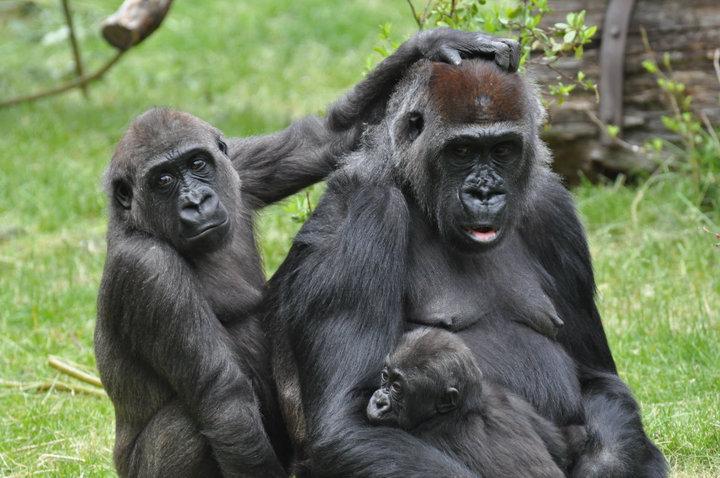
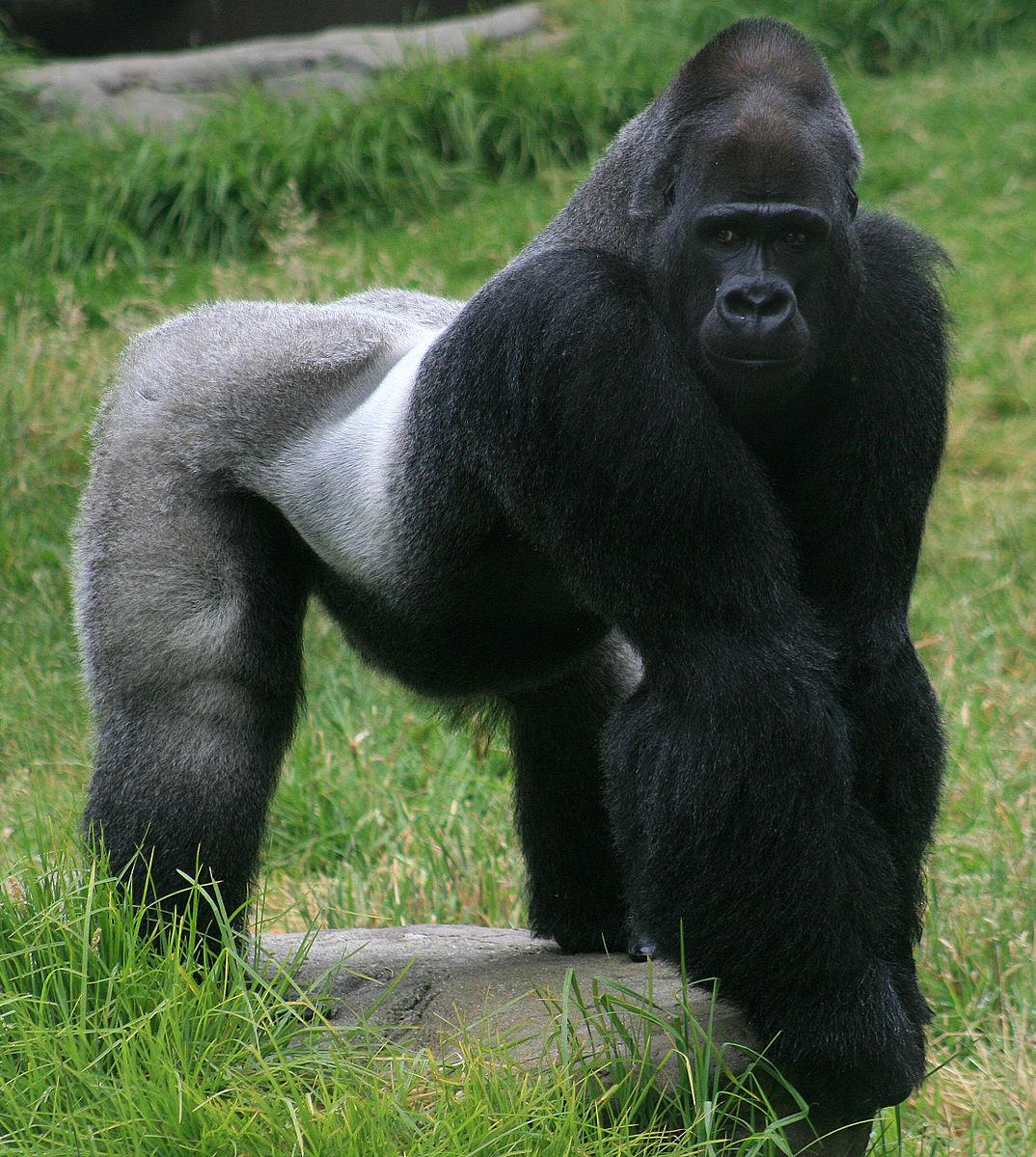
There are several species of gorillas that can be found across Central Africa. Gorilla males, like orangutan males, are about twice the size of female gorillas (Figures 30 and 31). When on the ground, gorillas use a form of quadrupedalism called knuckle-walking, where the fingers are curled under and the weight is carried on the knuckles. Male gorillas have a large sagittal crest and larger canines compared with females. Adult male gorillas are often called “silverbacks” because when they reach about twelve to thirteen years old, the hair on their backs turns silvery gray. Gorillas typically live in groups of one male and several females. Gorillas are considered folivorous, although they can be more frugivorous depending on fruit seasonality.
Pan of Africa

The Genus Pan includes two species: Pan troglodytes (the common chimpanzee) and Pan paniscus (the bonobo). These species are separated by the Congo River, with chimpanzees ranging across West and Central Africa and bonobos located in a restricted area south of the Congo River. Chimpanzees and bonobos both have broad, largely frugivorous diets and similar social groups. The two species differ morphologically in that bonobos are slightly smaller, have their hair parted down the middle of their foreheads, and are born with dark faces (Figure 32). In contrast, chimpanzees do not have the distinctive parted hair and are born with light faces which darken as they mature (Figure 33). Chimpanzees and bonobos live in a grouping called a fission-fusion community, which means they will gather in larger groups when there is enough food to support them, but otherwise forage in smaller groups. Both species are moderately sexually dimorphic, with males about 20% larger than females. When on the ground, chimpanzees and bonobos knuckle-walk like gorillas do.

Homo
The last member of the Hominoidea to discuss is our own taxon, the genus Homo. Humans differ from apes in many aspects, but there are clear similarities between humans and the other apes in our morphology and life history. Like other hominoids, humans lack a tail and possess upper-body adaptations for brachiation. While our lower body has been modified for a bipedal gait, we are still able to swing from branches or “monkey bars,” or throw a fastball, all thanks to our mobile shoulder joint. Humans, like other hominoids, also have primitive molars. As discussed earlier, all hominoids have an extended life history, taking a long time to grow and develop, and have a long life span. Humans, too, exhibit these same characteristics. Lastly, while humans show a great deal of variation across cultures, many human societies show patterns of female dispersal in which males stay in the group into which they were born while females leave.
Among the hominoids, humans show particular affinities with other members of the African apes, Pan and Gorilla. Humans share over 96% of our DNA with gorillas (Scally et al. 2012), and over 98% with Pan (Ebersberger et al. 2002). Our closest living relatives today are chimpanzees and bonobos. Because of our close relationship, humans share many additional traits in common with Pan. Humans, chimpanzees, and bonobos all live in similar social groups that are characterized by territoriality and male cooperation, among other things. Chimpanzee males are well-known to cooperate in hunting, a common trait across human societies as well. Chimpanzee populations have also been observed to make and use tools for different purposes, not unlike what humans do.
Learning from Primates
While primates are fascinating animals in their own right, we study non-human primates in anthropology with the ultimate goal of understanding more about our own biology and evolutionary history. The close relationship between humans and non-human primates makes them excellent for studying humans via homology, looking at traits that are shared between two taxa because they inherited the trait from a common ancestor. Consider, for example, the characteristics discussed in the previous section that are shared by humans and Pan. Since both taxa exhibit these traits, they are likely homologous, meaning these shared traits were probably present in the last common ancestor of humans and Pan approximately 6-8 million years ago .
Non-human primates also make excellent comparators for learning about humans via analogy (sometimes called convergent evolution, parallel evolution, or homoplasy). Many non-human primates live in environments or social groups similar to those in which our ancestors lived and therefore exhibit similar behavioral and morphological traits as what we see in humans. For example, baboons and humans share the trait of having long legs. In humans, this is because about 1.8 million years ago, our ancestors moved into open savanna habitats, like those baboons live in today, and longer legs enabled them to move over long distances more efficiently. Baboons independently evolved longer arms and legs for the same reason—to be able to cover more ground, more efficiently, in an open habitat. This means that having long legs is an analogous trait in baboons and humans—that is, this adaptation evolved independently in the two species but for the same purpose.
Primate evolution
As described in the sections above, primates have been evolving for about 66 million years – since the time period known as the Paleoecene. These earliest primates are identified by their teeth, and are found in a variety of places that are unexpected given today’s primate distributions – but 66 million years ago, the environment around the globe was very different (Figure 34).
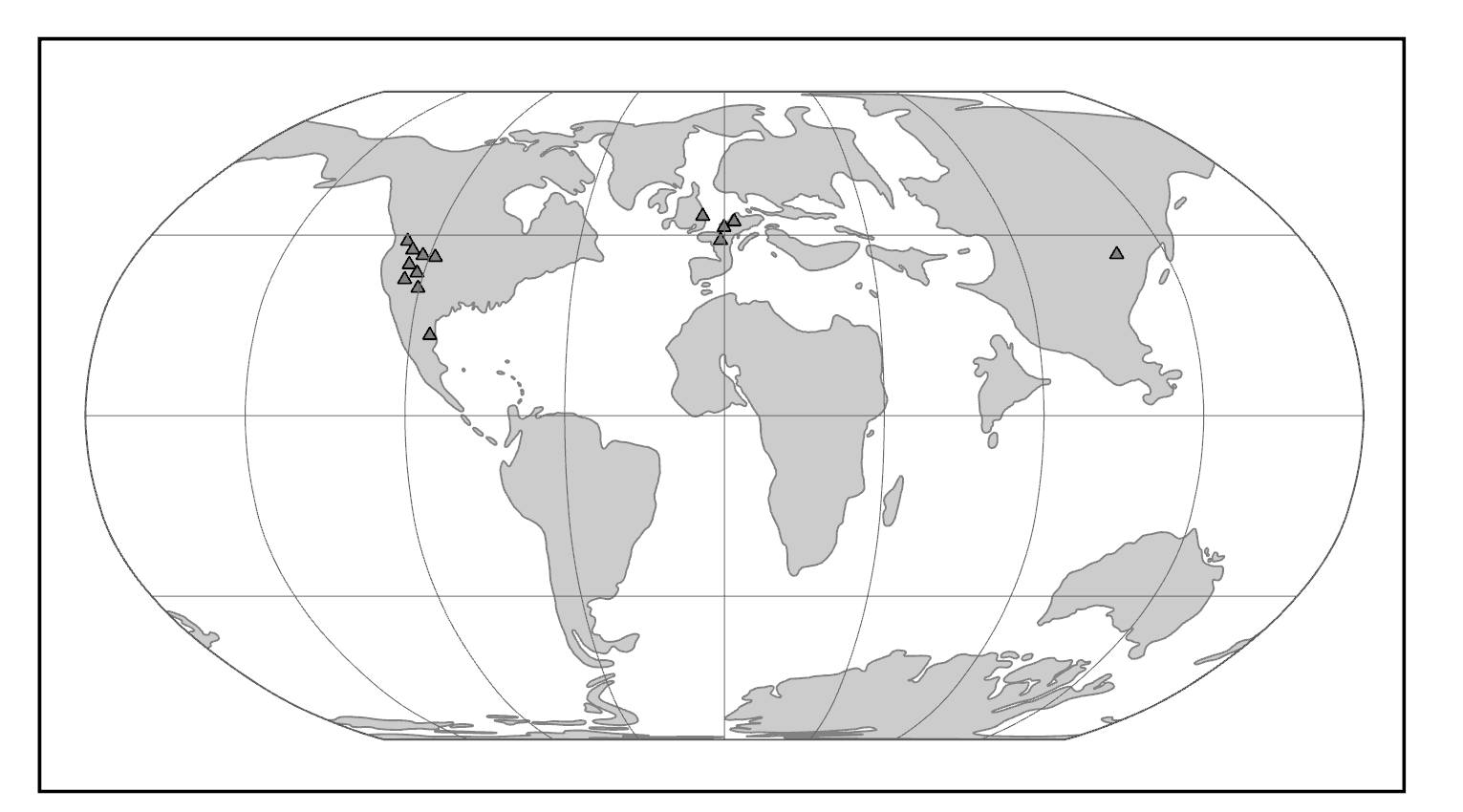
By the Eocene time period (about 55-33 million years ago), primate ancestors were clearly recognizable in the fossil record and were distributed in even more areas. As a group they were pretty diverse.
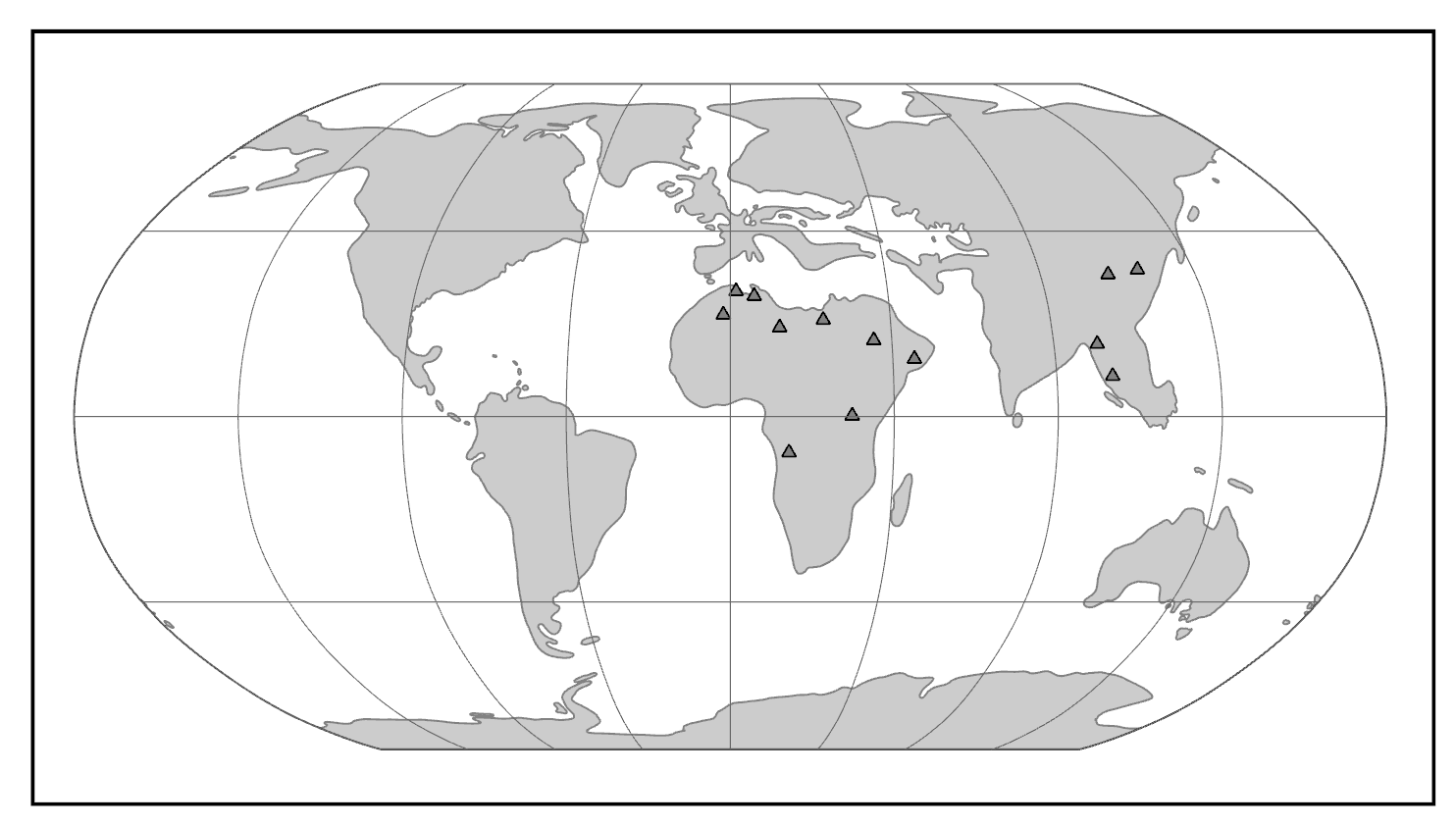
Changing global climate has had profound effects on primate dispersal patterns and ecological habits over evolutionary time. Primates today are strongly tied to patches of trees and particular plant parts such as fruits, seeds, and immature leaves. It is no surprise, then, that the distribution of primates mirrors the distribution of forests. Today, primates are most diverse in the tropics and especially in tropical rainforests. Global temperature trends across the Tertiary have affected primate ranges. Following the Cretaceous-Tertiary event when dinosaurs went extinct, cooler temperatures and greater seasonality characterized the Paleocene. In the Eocene, temperatures (and probably rainfall) increased globally and rainforests likely extended to very high latitudes. During this time, early primate ancestors became very diverse. With cooling and increased aridity at the end of the Eocene, many primate extinctions occurred in the northern continents and the surviving primates were confined to lower latitudes in South America, Afro-Arabia, Asia, and southern Europe. Among these survivors are the progenitors of the living groups of primates: lemurs and lorises, tarsiers, Central and South American monkeys, African and Asian monkeys, and apes (Figure 35).
By the Oligocene epoch (between about 65 and 23 million years ago), researchers see the first early monkeys in the fossil record. The classic localities yielding the greatest wealth of early ancestral monkey and ape fossils are those from the Fayum Basin in Egypt (Figure 36). The Fayum is a veritable oasis of fossil primates in an otherwise rather spotty African fossil record from this time period. The Fayum Jebel Qatrani Formation and Birket Qarun Formation between them have yielded a remarkable array of terrestrial, arboreal, and aquatic mammals. These include ungulates, bats, sea cows, elephants, hyraces, rodents, whales, and primates. Also, many other vertebrates, like water birds, were present. The area at the time of deposition (Late Eocene through Early Oligocene) was probably very wet, with slow-moving rivers, standing water, swampy conditions, and lots of trees. In short, it was an excellent place for primates.

Monkey Dispersal to South America
Today there is an impressive diversity of primates in South and Central America. Primates colonized South America sometime in the Eocene from an African source – likely those ancestors discovered in the Fayum. How monkeys arrived in Central and South America is a great debate – partly because South America was an island in the Eocene. Primates needed to cross open ocean to get there from either North America or Africa, although the distance from the former was shorter. The first known primates in South America have more in common morphologically with African primates than with North American ones.
The means by which a population of small North African primates managed to disperse across the Atlantic and survive to colonize South America remains a mystery. The most plausible scenario is one of rafting. That is, primates must have been trapped on vegetation that was blown out to sea by a storm. The vegetation then became a sort of life raft, which eventually landed ashore, dumping its passengers in South America. Rodents probably arrived in South America in the same way.
Once ashore, these monkey ancestors must have crossed South America fairly rapidly because the earliest-known primates from that continent are from Peru. By the Miocene epoch (between about 23 million to 5 million years ago), monkeys were living in extreme southern Argentina and were exploiting a variety of feeding niches. The story of South and Central American monkeys seems to be one of amazing dispersal, followed by rapid diversification and widespread geographic colonization of much of South America. After that, dramatic extinctions resulted in the current, much smaller geographic distribution of of these monkeys. These extinctions were probably caused by changing climates, leading to the contraction of forests.
Planet of Apes
The Miocene Epoch was a time of mammalian diversification and extinction, global climate change, and ecological turnover. In the Miocene, there was an initial warming trend across the globe with the expansion of subtropical forests, followed by widespread cooling and drying with the retreat of tropical forests and replacement with more open woodlands and eventually grasslands. It was also a time of major geologic activity. On one side of the globe, South America experienced the rise of the Andes Mountains. On the other side, the Indian subcontinent collided with mainland Asia, resulting in the rise of the Himalayan Mountains. In Africa, volcanic activity promoted the development of the East African Rift System. Critical to the story of ape evolution was the exposure of an intercontinental landbridge between East Africa and Eurasia, permitting a true planet of apes (Figure 37).
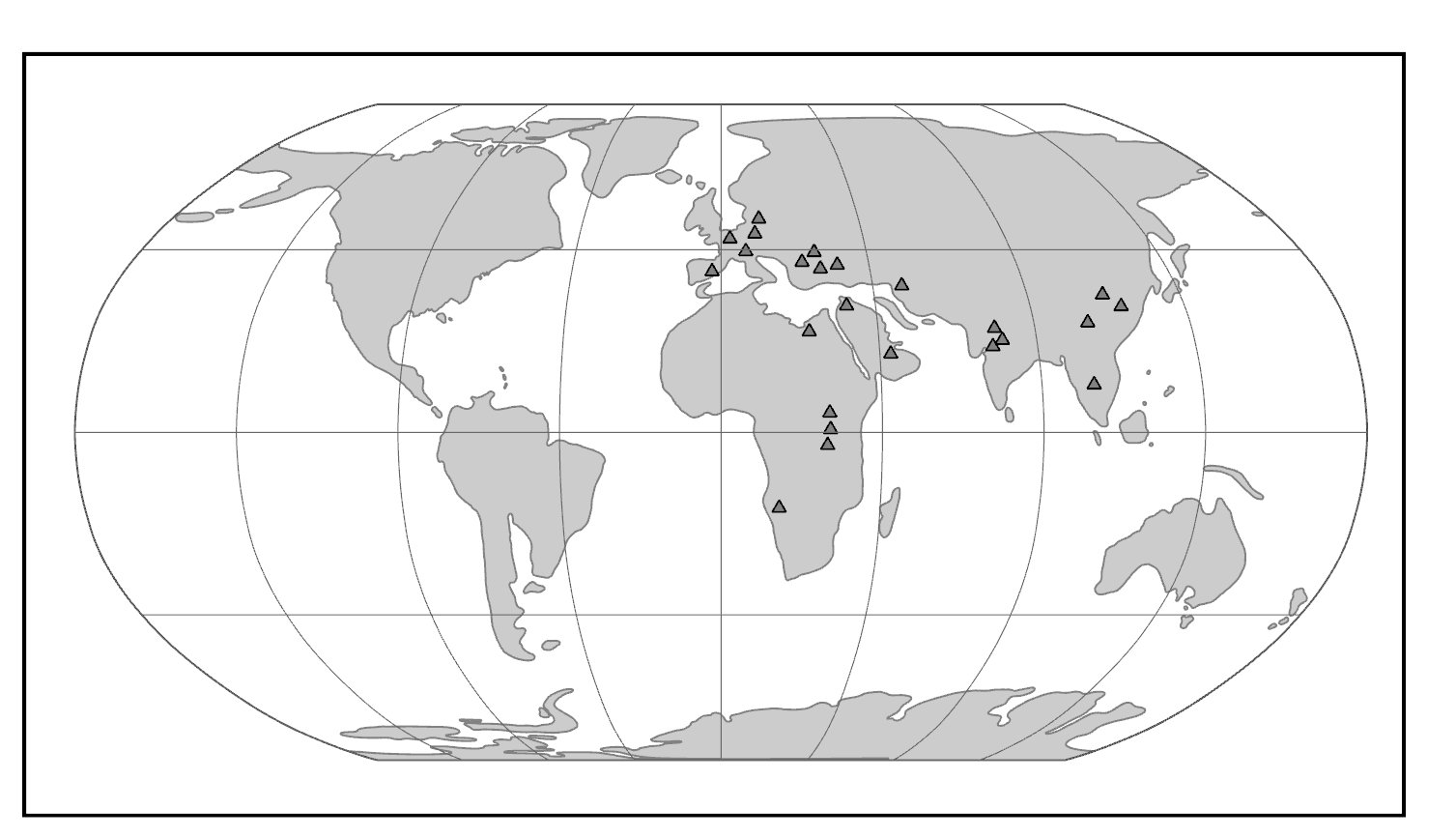
The world of the Miocene had tremendous ape diversity compared to today. The earliest records of fossil apes are from Early Miocene deposits in Africa. Though most of these early apes left no modern descendants, some of them gave rise to the ancestors of modern apes—including hominins. The Early Miocene of Africa has yielded around 14 genera of early apes. Many of these taxa have been reconstructed as frugivorous arboreal quadrupeds. Overall, the African ape fossil record in the Late Miocene is sparse, with seven fossil localities dating between eleven and five million years ago. Nevertheless, most species of great apes live in Africa today. Where did the progenitors of modern African apes arise? Did they evolve in Africa or somewhere else? The paucity of apes in the Late Miocene of Africa stands in contrast to the situation in Eurasia. There, ape diversity was high.
The fossil record of the extant apes is somewhat underwhelming: it ranges from being practically nonexistent for some taxa (e.g., chimpanzees) to being a little better for others (e.g., humans). There are many possible reasons for these differences in fossil abundance, and many are associated with the environmental conditions necessary for the fossilization of bones. One way to understand the evolution of extant apes that is not so dependent on the fossil record is via molecular evolutionary analyses. This can include counting up the differences in the genetic sequence between two closely related species to estimate the amount of time since these species shared a common ancestor. This is called a molecular clock, and it is often calibrated using fossils of known absolute age that stand in for the last common ancestor of a particular clade. Molecular clock estimates have placed the split between Hylobatidae and Hominidae between 19.7 million and 24.1 million years ago, followed by an African ape and Asian ape split between 15.7 million and 19.3 million years ago, and, finally, with the more recent radiation of Hylobatidae into its current genera between 6.4 million and 8 million years ago (Israfil et al. 2011).
The most extensive fossil record of a modern great ape is that of our own genus, Homo. The evolutionary history of the Asian great ape, the orangutan (Pongo), is becoming clearer. Today, orangutans are found only on the islands of Borneo and Sumatra. However, Pleistocene-aged teeth, attributed to Pongo, have been found in Cambodia, China, Laos, Peninsular Malaysia, and Vietnam—demonstrating the vastness of the orangutan’s previous range. Sivapithecus from the Miocene of India and Pakistan is represented by many specimens, including parts of the face. Sivapithecus is very similar to Pongo, especially in the face, and it probably is closely related to ancestral orangutans. Postcranial bones of Sivapithecus, however, suggest a more generalized locomotor mode—including terrestrial locomotion—than seen in Pongo.
In Africa, the first fossil to be confidently attributed to Pan, and known to be the earliest evidence of a chimpanzee, was described based on teeth found in Middle Pleistocene deposits in the Eastern Rift Valley of Kenya. Paleoenvironmental reconstructions of this locality suggest that this early chimpanzee was living in close proximity to early Homo in a closed-canopy wooded habitat. Similarly, fossil teeth and mandibular remains attributed to two species of Middle-Late Miocene apes—Chororapithecus abyssinicus (from Ethiopia) and Nakalipithecus nakayamai (from Kenya)—have been suggested as basal members of the gorilla clade.
Clearly, more work is needed to fill in the large gaps in the fossil record of the non-human great apes. The 20th century witnessed the discovery of many hominin fossils in eastern Africa, which have been critical for improving our understanding of human evolution. While 21st-century conservationists fight to prevent the extinction of the living great apes, perhaps efforts by 21st-century paleoanthropologists will yield the evolutionary story of these, our closest relatives.
Why study primates
The Order Primates is a diverse and fascinating group of animals united in sharing a suite of characteristics—visual specialization, grasping hands and feet, large brains, and extended life histories—that differentiates us from other groups of mammals. In this chapter, we surveyed the major taxonomic groups of primates, discussing where humans fit among our close relatives as well as discovering that primates are interesting animals in their own right. We discussed a range of key traits used to distinguish between the many taxa of living primates, including dietary, locomotor, and behavioral characteristics. Because of our long, shared evolutionary history with these animals, non-human primates provide a crucial resource for understanding our current biology.
Terms You Should Know
Study Questions
- Why does the field of anthropology, a field dedicated to the study of humans, include the study of non-human animals? What important things can we learn from non-human primates in anthropology?
- Draw out a tree showing the major taxonomic group of primates described here, making sure to leave room in between each level. Underneath each taxon, list some of the key features of this group so that you can compare traits between groups.
- How does a primate’s ecology affect their diet and interactions with other organisms?
References
Changizi, Mark A., Qiong Zhang, and Shinsuke Shimojo. 2006. Bare Skin, Blood and the Evolution of Primate Colour Vision. Biology Letters 2 (2): 217–221.
Chivers, David J., and C. M. Hladik. 1980. Morphology of the Gastrointestinal Tract in Primates: Comparisons With Other Mammals in Relation to Diet. Journal of Morphology, 166 (3): 337–386.
Clutton‐Brock, T. H., and Paul H. Harvey. 1980. Primates, Brains, and Ecology. Journal of Zoology, 190(3): 309–323.
Dominy, Nathaniel J., and Peter W. Lucas. 2001. Ecological Importance of Trichromatic Vision to Primates. Nature 410(6826): 363–366.
Dunbar, Robin I. M. 1998. The Social Brain Hypothesis. Evolutionary Anthropology 6(5): 178–190.
Ebersberger, Ingo, Dirk Metzler, Carsten Schwarz, and Svante Pääbo. 2002. Genomewide Comparison of DNA Sequences Between Humans and Chimpanzees. American Journal of Human Genetics, 70(6): 1490–1497.
Israfil, Hulya, Sarah M. Zehr, Alan R. Mootnick, Maryellen Ruvolo, and Michael E. Steiper. 2011. Unresolved Molecular Phylogenies of Gibbons and Siamangs (Family: Hylobatidae) Based on Mitochondrial, Y-linked, and X-linked Loci Indicate a Rapid Miocene Radiation or Sudden Vicariance Event. Molecular Phylogenetics and Evolution 58(3): 447–455.
Matsui, Atsushi, Felix Rakotondraparany, Isao Munechika, Masami Hasegawa, and Satoshi Horai. 2009. Molecular Phylogeny and Evolution of Prosimians Based on Complete Sequences of Mitochondrial DNAs. Gene, 441(1–2): 53–66.
Morgan, M. J., A. Adam, and J. D. Mollon. 1992. Dichromats Detect Colour-Camouflaged Objects That Are Not Detected by Trichromats. Proceedings of the Royal Society London B: Biological Sciences, 248 (1323): 291–295.
Nater, Alexander, Maja P. Mattle-Greminger, Anton Nurcahyo, Matthew G. Nowak, Marc De Manuel, Tariq Desai, Colin Groves, et al. 2017. Morphometric, Behavioral, and Genomic Evidence for a New Orangutan Species. Current Biology, 27(22): 3487–3498.
Pozzi, Luca, Jason A. Hodgson, Andrew S. Burrell, Kirstin N. Sterner, Ryan L. Raaum, and Todd R. Disotell. 2014. Primate Phylogenetic Relationships and Divergence Dates Inferred From Complete Mitochondrial Genomes. Molecular Phylogenetics and Evolution, 75: 165–183.
Regan, B. C., C. Julliot, B. Simmen, F. Viénot, P. Charles-Dominique, and J. D. Mollon. 2001. Fruits, Foliage and the Evolution of Primate Colour Vision. Philosophical Transactions of the Royal Society of London B: Biological Sciences, 356(1407): 229–283.
Scally, Aylwyn, Julien Y. Dutheil, LaDeana W. Hillier, Gregory E. Jordan, Ian Goodhead, Javier Herrero, Asger Hobolth, et al. 2012. Insights Into Hominid Evolution From the Gorilla Genome Sequence. Nature 483(7388): 169–175.
Schneider, Horacio, and Iracilda Sampaio. 2015. The Systematics and Evolution of New World Primates: A Review. Molecular Phylogenetics and Evolution, 82(B): 348–357.
Silk, Joan B., Jacintha C. Beehner, Thore J. Bergman, Catherine Crockford, Anne L. Engh, Liza R. Moscovice, Roman M. Wittig, Robert M. Seyfarth, and Dorothy L. Cheney. 2009. The Benefits of Social Capital: Close Social Bonds Among Female Baboons Enhance Offspring Survival. Proceedings of the Royal Society of London B: Biological Sciences 276(1670): 3099–3104.
A Derivative Work From
Etting, Stephanie. 2023. Meet the Living Primates. In Shook, Beth; Nelson, Katie; Aguilera, Kelsie; and Braff, Lara (eds.). Explorations: An Open Invitation to Biological Anthropology, Second Edition. American Anthropological Association.
Perry, Jonathan M.G. and Canington, Stephanie L. 2023. Primate Evolution. In Shook, Beth; Nelson, Katie; Aguilera, Kelsie; and Braff, Lara (eds.). Explorations: An Open Invitation to Biological Anthropology, Second Edition. American Anthropological Association.
Plural for taxon; a taxonomic group of any rank, such as species, family, or class.
Physical trait that a taxon has because it has inherited the trait from a distant ancestor.
Physical trait of a taxon that has more recently evolved, and can be used to distinguish narrower taxonomic groupings.
A trait that is useful for a wide range of tasks.
Having thumbs and/or toes that go in a different direction from the rest of the fingers and/or toes, allows for grasping with hands and feet.
A trait that has been developed for a specific purpose.
A bony ring that surrounds the eye socket, open at the back; this is a derived trait of all primates.
Being able to distinguish yellows and reds in addition to blues and greens; this is a trait shared by many primates.
When an organism, which is limited in the time and energy it can put into aspects of its biology and behavior, is shaped by natural selection to invest in one adaptation at the expense of another.
An organism that spends most of its time in trees.
Having five digits (fingers and toes)
An organism that spends most of its time on the ground.
Sensitive skin at the fingertips for sense of touch. Animals with a prehensile tail have a tactile pad on the underside of the tail as well.
An organism having different types of teeth
The size difference between males and females of any species
A space between the teeth, usually for large canines to fit when the mouth is closed.
The number of each type of tooth in one quadrant of the mouth, written as number of incisors: canines: premolars: molars.
Having a diet consisting primarily of fruit.
Having a diet consisting primarily of insects.
Having a diet consisting primarily of leaves.
Having a diet consisting primarily of gums and saps.
Refers to the time of day an animal is typically active.
How an organism moves around.
A locomotor pattern in which animals are oriented upright while clinging to vertical branches, push off with hind legs, and land oriented upright on another vertical branch.
Moving around on all fours.
A form of locomotion in which the organism swings below branches using the forelimbs.
A tail that is able to hold the full body weight of an organism, which often has a tactile pad on the underside of the tip for improved grip.
Walking on two legs.
A grouping based on ancestral relationships; a branch of the evolutionary tree.
A claw present on the second pedal digit in strepsirrhines.
A trait of the front, lower teeth of strepsirrhines in which, typically, the four incisors and canines are long and thin and protrude outward. Also known as dental comb.
Reflecting layer at the back of the eye that magnifies light.
The nose and upper lip are separated and the upper lip can move independently; sometimes referred to as a “hairy” or “mobile” upper lip.
A system in which individuals of a species vary in their abilities to see color. In primates, it refers to males being dichromatic and females being either trichromatic or dichromatic.
Molar pattern of cercopithecoid monkeys in which there are usually four cusps that are arranged in a square pattern and connected by two ridges.
Modified seat bones of the pelvis that are flattened and over which calluses form; function as seat pads for sitting and resting atop branches.
A bony ridge along the top/middle of the skull, used for attachment of chewing muscles.
A form of quadrupedal movement used by gorillas and chimpanzees when on the ground, wherein the front limbs are supported on the knuckles of the hands.
The study of physical correspondences among diverse kinds of creatures; necessary for creating taxonomies
Evolutionary process whereby organisms that are not closely related independently evolve similar traits as a product of adaptation to similar evolutionary parameters.
Modern humans and any extinct relatives more closely related to us than to chimpanzees.

